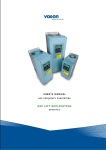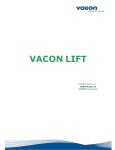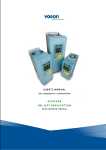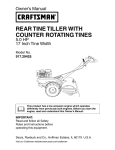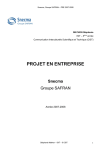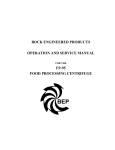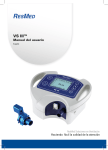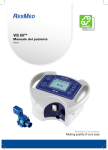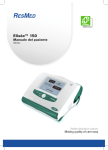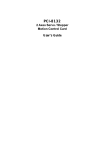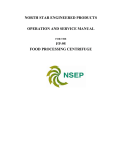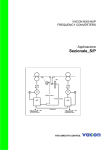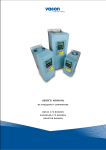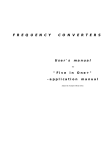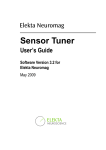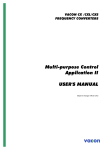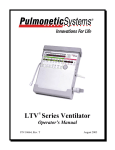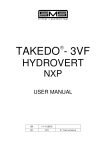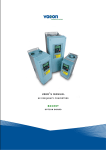Download user`s manual standard lift application
Transcript
user's manual nx frequency converters standard lift application asfiff08 2 • vacon Vacon Standard Lift Application (Software ASFIFF08) INDEX 1. Introduction ....................................................................................................................... 4 2. Programming principle of the Input signals ...................................................................... 5 2.1 2.2 Defining an input for a certain function on keypad.................................................................... 6 Defining a terminal for a certain function with NCDrive programming tool............................ 7 3. Control I/O ......................................................................................................................... 8 4. Lift Application – Parameter lists ...................................................................................... 9 4.1 4.2 4.3 4.4 4.5 4.6 4.7 4.8 4.9 4.10 4.11 4.12 4.13 4.14 4.15 5. Description of parameters ............................................................................................... 21 5.1 5.2 5.3 5.4 5.5 5.6 5.7 5.8 5.9 5.10 5.11 5.12 6. BASIC PARAMETERS ................................................................................................................ 21 SPEED CONTROL...................................................................................................................... 22 MECHANICAL BRAKE CONTROL ............................................................................................. 27 DRIVE CONTROL ....................................................................................................................... 36 MOTOR CONTROL ..................................................................................................................... 38 INPUT SIGNALS ........................................................................................................................ 42 OUTPUT SIGNALS ..................................................................................................................... 45 PROTECTIONS........................................................................................................................... 49 AUTO RESTART PARAMETERS ................................................................................................ 57 EVACUATION PARAMETERS .................................................................................................... 59 CLOSED LOOP PARAMETERS .................................................................................................. 61 KEYPAD CONTROL PARAMETERS ........................................................................................... 63 Commissioning of the Lift application.............................................................................. 64 6.1 6.2 6.3 7. Monitoring values (Control keypad: menu M1).......................................................................... 9 Basic parameters (Control keypad: Menu M2 Æ G2.1) ........................................................... 10 Speed Control Parameters (Control keypad: Menu M2 Æ G2.2) ............................................ 10 Mechanical Brake control parameters (Control keypad: Menu M2 Æ G2.3).......................... 12 Drive control parameters (Control keypad: Menu M2 Æ G2.4)............................................... 13 Motor control parameters (Control keypad: Menu M2 Æ G2.5).............................................. 13 Input signals (Control keypad: Menu M2 Æ G2.6) ................................................................... 14 Output signals (Control keypad: Menu M2 Æ G2.7)................................................................. 15 Protections (Control keypad: Menu M2 Æ G2.8)...................................................................... 17 Autorestart parameters (Control keypad: Menu M2 Æ G2.9) ................................................. 18 Evacuation parameters (Control keypad: Menu M2 Æ G2.10) ................................................ 19 Closed loop parameters (Control keypad: Menu M2 Æ G2.11)............................................... 19 Keypad control (Control keypad: Menu M3)............................................................................. 20 System menu (Control keypad: M6) ......................................................................................... 20 Expander boards (Control keypad: Menu M7) ......................................................................... 20 Installation of the NX drive ....................................................................................................... 64 General setup of parameters ................................................................................................... 65 Tuning of the application .......................................................................................................... 65 Control signal logic in THE LIFT Application .................................................................... 69 Tel. +358 (0)201 2121 • Fax +358 (0)201 212 205 Introduction 8. vacon • 3 Fault Tracing.................................................................................................................... 70 24-hour support +358 (0)40 837 1150 • Email: [email protected] 4 • vacon 1. Introduction INTRODUCTION Select the Lift Application in menu M6 on page S6.2. The Lift Application can be used with modern Lift systems. There are functions included that are required to achieve a smooth ride in the lift car. The I/O interface table includes the most commonly needed signals in lift applications. In the application, constant speeds are presented in [m/s] and also in [Hz], acceleration and deceleration are presented in [m/s2] and jerks are presented in [ms]. Mechanical brake control logic is designed to achieve smooth departures from and landings to floor level. The brake can be set in various ways to meet the different requirements of lift motors and lift control logic. The used hardware can be any Vacon NXS or NXP frequency converter. In closed loop motor control mode NXP drive and encoder option board is required (NXOPTA4 or NXOPTA5). All outputs are freely programmable. Digital input functions are freely programmable to any digital input. Start forward and reverse signals are fixed to input DIN1 and DIN2 (see next page). Tel. +358 (0)201 2121 • Fax +358 (0)201 212 205 Programming principle of the Input signals 2. vacon • 5 PROGRAMMING PRINCIPLE OF THE INPUT SIGNALS The programming principle of the input signal in the Lift Application as well as in the Multipurpose Control Application (and partly in the other applications) is different compared to the conventional method used in other Vacon NX applications. In the conventional programming method, Function to Terminal Programming Method (FTT), you have a fixed input that you define a certain function for. The applications mentioned above, however, use the Terminal to Function Programming method (TTF) in which the programming process is carried out the other way round: Functions appear as parameters that the operator defines certain input for (see Figure below). APPLICATIO N IN PUT SIGN A LS "ADRESS 0 .x " Address 0.1 Parameter 2.6 .7 .1 Ex terna l Fa ult, cc FALSE 0 .1 Parameter 2.6 .7 .2 Address 0.2 -0.10 0 .2 Ex tern a l Fa ult, oc TRU E Parameter 2.6 .7 .3 A.3 Fa ult Reset SLO T A Parameter 2.6 .7 .4 Run En a ble o o o Sp eed SEL 1 " Input 1 0" = A.1 0 .1 " Input 1 1" = A.2 Parameter 2.6 .7 .10 " Input 1 2" = A.3 A.4 " Input 1 3" = A.4 Parameter 2.6 .7 .11 Sp eed SEL 2 " Input 1 4" = A.5 A.5 Parameter 2.6 .7 .12 Sp eed SEL 3 " Input 1 5" = A.6 A.6 SLO T B Parameter x.x Inp ut Sig na l X " Input 2 0" = B.1 B.1 " Input 2 1" = B.2 " Input 2 2" = B.3 Figure 1. Basic principle of the Terminal to Function Programming method (TTF). Note: Constant value can be given to input signal. Value 0.1 is a constant FALSE and values from 0.2 through 0.10 are constant TRUE (see Figure 1). 24-hour support +358 (0)40 837 1150 • Email: [email protected] 6 • vacon 2.1 Programming principle of the Input signals Defining an input for a certain function on keypad Connecting a certain function (input signal) to a certain digital input is done by giving the parameter an appropriate value. The value is formed of the Board slot on the Vacon NX control board (see Vacon NX User's Manual, Chapter 6.2) and the respective signal number, see below. READY I/O term Function name Fault reset DigIN:0.1 Slot Terminal type Terminal number Example: You want to connect the digital input function Fault Reset (parameter 2.6.7.3) to a digital input A.3 on the basic board NXOPTA1, located in Slot A. First find the parameter 2.6.7.3 on the keypad. Press the Menu button right once to enter the edit mode. On the value line, you will see the terminal type on the left (DigIN) and on the right, digital input where function is connected. When the value is blinking, hold down the Browser button up or down to find the desired board slot and signal number. The program will scroll the board slots starting from 0 and proceeding from A to E and the I/O numbers from 1 to 10. Once you have set the desired value, press the Enter button once to confirm the change. READY I/Oterm Fault reset DigIN:0.1 READY I/Oterm Fault reset DigOUT:0.1 READY I/Oterm Fault reset DigOUT:A.3 enter Tel. +358 (0)201 2121 • Fax +358 (0)201 212 205 Programming principle of the Input signals 2.2 vacon • 7 Defining a terminal for a certain function with NCDrive programming tool If you use the NCDrive Programming Tool for parametrizing you will have to establish the connection between the function and input/output in the same way as with the control panel. Just pick the address code from the drop-down menu in the Value column (see the Figure below). Figure 2. Screenshot of NCDrive programming tool; Entering the address code Note: Two input signals can be connected to same digital input. However, use this feature very considerably. 24-hour support +358 (0)40 837 1150 • Email: [email protected] 8 • vacon 3. Control I/O CONTROL I/O NXOPTA1 READY mA Terminal 1 +10Vref 2 AI1+ Signal Reference output Analogue input, voltage range 0—10V DC Description Voltage for potentiometer, etc. Voltage input frequency reference 3 4 5 AI1AI2+ AI2- I/O Ground Analogue input, current range 0—20mA Ground for reference and controls Current input frequency reference 6 7 8 +24V GND DIN1 Voltage for switches, etc. max 0.1 A Ground for reference and controls Contact closed = start forward 9 DIN2 10 DIN3 11 CMA Control voltage output I/O ground Start forward (programmable) Start reverse (programmable) Fault Reset (programmable) Common for DIN 1—DIN 3 12 13 14 +24V GND DIN4 Control voltage output I/O ground Speed reference selection 15 DIN5 Speed reference selection 16 DIN6 Speed reference selection 17 18 19 20 CMB AO1+ AO1DO1 Common for DIN4—DIN6 Output frequency Analogue output Digital output FAULT Contact closed = start reverse Contact open = no fault Contact closed = fault Connect to GND or +24V Voltage for switches (see #6) Ground for reference and controls Programmable speed reference for Inputs DIN4, DIN5, and DIN6: Activity reference Activity reference with direction Binary Reference Connect to GND or +24V Programmable Range 0—20 mA/RL, max. 500Ω Programmable Open collector, I≤50mA, U≤48 VDC NXOPTA2 RUN 220 VAC 21 22 23 RO1 RO1 RO1 Relay output 1 RUN Programmable 24 25 26 RO2 RO2 RO2 Relay output 2 Mechanical brake Programmable Table 1. Standard application default I/O configuration. Note: See jumper selections below. More information in Vacon NX User's Manual, Chapter 6.2.2.2. Jumper block X 3 : CM A a nd CM B grounding CMB connected to GN D CMA connected to GN D CMB isolated from GN D CMA isolated from GN D CMB and CMA internally connected together, isolated from GN D = Factory default Tel. +358 (0)201 2121 • Fax +358 (0)201 212 205 Lift Application – Parameter lists 4. vacon • 9 LIFT APPLICATION – PARAMETER LISTS On the next pages you will find the lists of parameters within the respective parameter groups. The parameter descriptions are given on pages 21 to 63. Column explanations: Code Parameter Min Max Unit Default Cust ID 4.1 = = = = = = = = = = Location indication on the keypad; Shows the operator the present parameter number Name of parameter Minimum value of parameter Maximum value of parameter Unit of parameter value; Given if available Value preset by factory Customer’s own setting ID number of the parameter (used with PC tools) Apply the Terminal to Function method (TTF) to these parameters. See Chapter 2. On parameter code: Parameter value can only be changed after the frequency converter has been stopped. Monitoring values (Control keypad: menu M1) The monitoring values are the actual values of parameters and signals as well as statuses and measurements. Monitoring values cannot be edited. See Vacon NX User's Manual, Chapter 7 for more information. Code V1.1 V1.2 V1.3 V1.4 V1.5 V1.6 V1.7 V1.8 V1.9 Parameter Output frequency Frequency reference Motor speed Motor current Motor torque Motor power Motor voltage DC link voltage Unit temperature V1.10 V1.11 V1.12 V1.13 V1.14 V1.15 V1.16 V1.17 V1.19 Voltage input Current input DIN1, DIN2, DIN3 DIN4, DIN5, DIN6 DO1, RO1, RO2 Analogue Iout Lift Speed Encoder Speed UnFiltered Motor Torq Speed ctrl out V1.20 Ramp Down Distance G1.21 Multimonitor V1.18 Unit Hz Hz rpm A % % V V °C V ID 1 25 2 3 4 5 6 7 8 mA m/s rpm 13 14 15 16 17 26 1630 1631 % 1632 % 1633 m 1634 mA Description Output frequency to motor Frequency reference to motor control Motor speed in rpm In % of the nominal motor torque Motor shaft power Heatsink temperature AI1 AI2 Digital input statuses Digital input statuses Digital and relay output statuses AO1 Lift speed in m/s Torque reference from speed controller output Distance when decelerated from any speed to levelling speed (or zero speed). Value visualizes the effect of different parameters to stopping distance. Three different value can be monitored at the same time Table 2. Monitoring values 24-hour support +358 (0)40 837 1150 • Email: [email protected] 10 • vacon 4.2 Lift Application – Parameter lists Basic parameters (Control keypad: Menu M2 Æ G2.1) Code Parameter Min Max Unit P2.1.1 Nominal voltage of the motor 180 690 V 2.1.2 Nominal frequency of the motor 30,00 320,00 Hz 50,00 111 P2.1.3 Nominal speed of the motor 300 20 000 rpm 1440 112 P2.1.4 Nominal current of the motor 1 x IL 2,5 x IL A IL 113 P2.1.5 Motor cosϕ 0,30 1,00 0,85 120 P2.1.6 Current limit 0,1 x IL 2,5 x IL 1,5 x IL 107 A Default NX2: 230V NX5: 400V NX6: 690V Cust ID Note 110 Check the rating plate of the motor The default applies for a 4pole motor and a nominal size frequency converter. Check the rating plate of the motor Check the rating plate of the motor NOTE: This applies for frequency converters up to FR7. For greater sizes, consult the factory. Table 3. Basic parameters G2.1 4.3 Speed Control Parameters (Control keypad: Menu M2 Æ G2.2) Code P2.2.1 P2.2.2 P2.2.3.x P2.2.3.1 P2.2.3.2 P2.2.3.3 P2.2.3.4 P2.2.3.5 P2.2.3.6 P2.2.3.7 P2.2.3.8 P2.2.3.9 P2.2.4.x P2.2.4.1 P2.2.4.2 P2.2.4.3 P2.2.4.4 P2.2.4.5 P2.2.4.6 P2.2.4.7 P2.2.4.8 P2.2.4.9 Parameter Nominal Linear Speed Speed Reference Selection Min Max Unit Default 0,20 5,00 m/s 1,00 0 Speed Reference [m/s] Levelling Speed 0,00 Full Speed 0,00 Limited Speed 0,00 Inspection Speed 0,00 Speed Reference 4 0,00 Speed Reference 5 0,00 Speed Reference 6 0,00 Speed Reference 7 0,00 Override speed 0,00 Speed Reference [Hz] Levelling Speed 0,00 Full Speed 0,00 Limited Speed 0,00 Inspection Speed 0,00 Speed Reference 4 0,00 Speed Reference 5 0,00 Speed Reference 6 0,00 Speed Reference 7 0,00 Override speed 0,00 Cust ID 1500 6 s 0 117 par2.2.1 par2.2.1 par2.2.1 m/s m/s m/s m/s m/s m/s m/s m/s m/s 0,10 1,00 0,25 0,50 0,10 1,00 0,25 0,50 0,50 1501 1502 1503 1504 1505 1506 1507 1508 1613 Hz Hz Hz Hz Hz Hz Hz Hz Hz 5,00 50,00 12,50 25,00 5,00 50,00 12,50 25,00 5,00 1604 1605 1606 1607 1608 1609 1610 1611 1612 1,5xP2.2.1 par2.2.1 par2.2.1 par2.2.1 par2.2.1 1,5xP2.2.1 par2.1.2 par2.1.2 par2.1.2 1,5xP2.1.2 par2.1.2 par2.1.2 par2.1.2 par2.1.2 1,5xP2.1.2 Note 0=Activity Reference 1=Activ ref. with direction 2=Binary reference 3=AI1 (Voltage input) 4=AI2 (Current input) 5=Fieldbus 6=Keypad Parameters correspond to parameters in group 2.2.4. They will be updated automatically if parameters are changed. These parametres are also updated when P2.2.1 is changed. Parameters correspond to parameters in group 2.2.3. They will be updated automatically if parameters are changed. Tel. +358 (0)201 2121 • Fax +358 (0)201 212 205 Lift Application – Parameter lists Code P2.2.5.x P2.2.5.1 P2.2.5.2 P2.2.5.3 P2.2.5.4 P2.2.5.5 P2.2.5.6 P2.2.6.x P2.2.6.1 P2.2.6.2 P2.2.6.3 P2.2.6.4 P2.2.6.5 P2.2.6.6 P2.2.6.7 Parameter SPEED CURVE 1 Acceleration Deceleration Acceleration increase jerk 1 Acceleration Decrease jerk 1 Deceleration increase jerk 1 Deceleration decrease jerk 1 SPEED CURVE 2 Internal Ramp Switch Acceleration 2 Deceleration 2 Acceleration increase jerk 2 Acceleration decrease jerk 2 Deceleration increase jerk2 Deceleration decrease jerk 2 vacon • 11 Min Max Unit Default 0,20 0,20 2,00 2,00 m/s2 m/s2 0,70 0,70 103 104 0,01 1,00 s 0,50 1540 0,01 1,00 s 0,25 1541 0,01 1,00 s 0,25 1542 0,01 1,00 s 0,50 1543 0 par2.1.2 Hz 0 1544 0,20 0,20 2,00 2,00 m/s2 m/s2 0,20 0,20 502 503 0,01 1,00 s 0,50 1545 0,01 1,00 s 0,50 1546 0,01 1,00 s 0,50 1547 0,01 1,00 s 0,50 1548 1 1549 0,00 1509 0 1614 P2.2.7 Enable jerks 0 1 P2.2.8 Reference hold time 0,00 5,00 P2.2.9 Stop State (DIN456) 0 1 s Table 4. Speed control parameters G2.1 24-hour support +358 (0)40 837 1150 • Email: [email protected] Cust ID Note 0=Normal operation 1=Stop if DIN456 are OFF 12 • vacon 4.4 Lift Application – Parameter lists Mechanical Brake control parameters (Control keypad: Menu M2 Æ G2.3) Code P2.3.1.x Parameter Min Max Unit Default Cust ID Note OPEN LOOP PARAMETERS Value is changed when parameter 2.1.4 is set. P2.3.1.1 Current limit 0 1,5 x In A 0,2 x In 1551 P2.3.1.2 P2.3.1.3 P2.3.1.4 P2.3.1.5 P2.3.1.6 0 0 0 0 0 100,0 10,00 1,00 20,00 5,00 % Hz s Hz s 30,0 1,00 0,10 1,00 0,00 1552 1553 1554 1555 1556 0 10,00 Hz 4,00 1557 0 1,00 s 0,05 1558 0,15 x In 1,5 x In A Varies 507 0,00 60,00 s 0,500 1559 0=DC brake is off at start 0,00 60,00 s 1,000 1560 0=DC brake is off at stop 0,10 10,00 Hz 0,50 515 P2.3.1.13 Torque limit Frequency limit Brake open delay Freq. limit close Brake close delay Max. Freq. brake closed Mechanical brake reaction time DC braking current DC braking time at start DC braking time at stop Frequency to start DC braking during ramp stop Delayed Brake 0,00 30,00 s 0,00 1640 P2.3.1.14 Run Request Closing 0 1 1 1641 0= Inactive 1= Active Value is changed when parameter 2.1.4 is set. P2.3.1.7 P2.3.1.8 P2.3.1.9 P2.3.1.10 P2.3.1.11 P2.3.1.12 P2.3.2.x CLOSED LOOP PARAMETERS P2.3.2.1 Current limit 0 1,5 x In A 0,2 x In 1561 P2.3.2.2 P2.3.2.3 P2.3.2.4 P2.3.2.5 P2.3.2.6 0 0 0 0 0 100,0 10,00 1,00 20,00 5,00 % Hz s Hz s 0 0,01 0,00 0,01 0,00 1562 1563 1564 1565 1566 0 10,00 Hz 0,10 1577 P2.3.2.8 P2.3.2.9 P2.3.210 P2.3.2.11 P2.3.2.12 Torque limit Frequency limit Brake open delay Freq. limit close Brake close delay Max. Freq. brake closed 0Hz time at start 0Hz time at stop Smooth start time Smooth start freq. Delayed Brake 0 0 0 0 0,00 2,000 2,000 1,00 5,00 30,00 s s s Hz s 0,400 0,600 0,10 0,02 0,00 615 616 1568 1569 1640 P2.3.2.13 Run Request Closing 0 1 1 1641 0.2 1601 0.2 1602 1,00 1603 P2.3.2.7 P2.3.3.x P2.3.3.1 P2.3.3.2 P2.3.4.x P2.3.4.1 DIGITAL INPUTS Ext. brake control Ext. brake supervision BRAKE SUPERVISION External brake 0,00 supervision time 5,00 s 0= Inactive 1= Active See page 5. Table 5. Mechanical brake control parameters, G2.4 Tel. +358 (0)201 2121 • Fax +358 (0)201 212 205 Lift Application – Parameter lists 4.5 vacon • 13 Drive control parameters (Control keypad: Menu M2 Æ G2.4) Code Parameter Min Max P2.4.1 Brake chopper 0 3 1 504 P2.4.2 Stop function 0 1 2 506 P2.4.3 P2.4.4 Frequency limit Stop distance Deceleration increase/ decrease time 0 0 MaxFreq 1,5 Hz m 5,00 0,0 1624 1539 0 1,00 s 0,15 1626 0 200 % 70 1625 P2.4.5 P2.4.6 Scaling factor Unit Default Cust ID Note 0=Disabled 1=Used when running 2=Ext. brake chopper 3=Used when stopped/running 0=Coasting 1=Ramping 2=Stop by Freq. limit Used only if par 4.2=2 0=Not used S-curve (jerk) time which is active only when Stop by distance is active Scaling factor for ramp time Table 6. Drive control parameters, G2.5 4.6 Motor control parameters (Control keypad: Menu M2 Æ G2.5) Code Parameter Min Max Unit Default Cust ID P2.5.1 Motor control mode 0 1 1 1572 P2.5.2 U/f optimisation 0 1 1 1573 P2.5.3 U/f ratio selection 0 3 0 1574 P2.5.4 Field weakening point 30,00 320,00 Hz 50,00 602 P2.5.5 Voltage at field weakening point 10,00 200,00 % 100,00 603 0,00 P2.6.4 Hz 5,00 1575 0,00 100,00 % 10,00 1576 n% x Unmot 0,00 40,00 % 1,30 1577 n% x Unmot 1,0 16,0 kHz Varies 601 Depends on kW 0=Not used 1=Used 0=Not used 1=Used Motor Identification in (OL), Motor Standstill P2.5.9 U/f curve midpoint frequency U/f curve midpoint voltage Output voltage at zero frequency Switching frequency P2.5.10 Overvoltage controller 0 1 0 607 P2.5.11 Undervoltage controller 0 1 0 608 P2.5.12 Identification 0 1 0 631 P2.5.13 P2.5.14 P2.5.15 Measured Rs Volt Drop IrAddGenScale IrAddMotorScale 0 0 0 10000 200 200 % % 0 100 662 665 667 P2.5.16 IrAddZeroPoVolt 0,00 100,00 % 0,00 664 P2.5.17 P2.5.18 OL SpeedCont kp OL SpeedCont ki 0 0 10000 10000 3000 300 1656 1655 P2.5.6 P2.5.7 P2.5.8 Table 7. Motor control parameters, G2.6 24-hour support +358 (0)40 837 1150 • Email: [email protected] Note 0=Frequency control 1=Speed control, (OL) 2=Speed control, (CL) 0=Not used 1=Automatic torque boost 0=Linear 1=Squared 2=Programmable 3=Linear with flux optim. n% x Unmot Parameter max. value = par. 2.6.7 Ir Add Voltage for Zero frequency Speed Controller kp1 Speed Controller ki1 14 • vacon 4.7 Lift Application – Parameter lists Input signals (Control keypad: Menu M2 Æ G2.6) Code Parameter Min Max Unit Default Cust ID P2.6.1 Start/Stop logic 0 6 0 300 P2.6.2 Current reference offset 0 1 1 302 P2.6.3 Reference scaling minimum value 0,00 par. 2.2.5 Hz 0,00 303 P2.6.4 Reference scaling maximum value 0,00 320,00 Hz 0,00 304 P2.6.5 Reference inversion 0 1 0 305 P2.6.6 P2.6.7.x Reference filter time 0,00 10,00 P2.6.7.1 P2.6.7.2 P2.6.7.3 P2.6.7.4 P2.6.7.5 P2.6.7.6 P2.6.7.7 P2.6.7.8 P2.6.7.9 P2.6.7.10 P2.6.7.11 P2.6.7.12 External Fault, closing contact External fault, opening contact Fault reset Run enable Acceleration/Decel time selection Stop by coast, closing contact Stop by coast, opening contact Override speed Forced I/O control Speed selection input 1 Speed selection input 2 Speed selection input 3 s 0,10 DIGITAL INPUTS 306 0.1 1513 0.2 1514 A.3 0.2 1515 1516 0.1 1517 0.1 1518 0.2 1519 0.1 0.1 1520 1521 A.4 1521 A.5 1522 A.6 1523 Note DIN1 0 1 2 Start fwdP Start/Stop Start fwd DIN2 Start rvsP Rvs/Fwd Start rev 0=No offset 1=4—20 mA Selects the frequency that corresponds to the min. reference signal 0,00 = No scaling Selects the frequency that corresponds to the min. reference signal 0,00 = No scaling 0=Not inverted 1=Inverted 0=No filtering See page 5. Table 8. Input signals, G2.2 Tel. +358 (0)201 2121 • Fax +358 (0)201 212 205 Lift Application – Parameter lists 4.8 vacon • 15 Output signals (Control keypad: Menu M2 Æ G2.7) Code Parameter Min Max P2.7.1 Analogue output function 0 8 0,00 10,00 0 P2.7.2 P2.7.3 P2.7.4 P2.7.5 P2.7.6 P2.7.7 P2.7.8 P2.7.9 P2.7.10 P2.7.11 P2.7.12 P2.7.13 Analogue output filter time Analogue output inversion Analogue output minimum Anal. output scale Digital output 1 function Digital output function 1 Digital output 1 ON delay Digital output 1 OFF Delay Relay output 1 function Relay output 1 function inverted Relay output 1 ON delay Relay output 1 OFF Delay Unit Default Cust ID 1 307 1,00 308 1 0 309 0 1 0 310 10 1000 100 311 s % 0 20 3 312 0 1 0 1530 0 10,00 s 0,00 1531 0 10,00 S 0,00 1657 0 14 2 313 0 1 0 1532 0 10,00 s 0,00 1533 0 10,00 S 0,00 1658 24-hour support +358 (0)40 837 1150 • Email: [email protected] Note 0=Not used 1=Output freq. (0—fmax) 2=Freq. reference (0—fmax) 3=Motor speed (0–Motor nominal speed) 4=Output current (0—InMotor 5=Motor torque (0—TnMotor) 6=Motor power (0—PnMotor) 7=Motor voltage (0--UnMotor) 8=DC-link volt (0—1000V) 0=Not inverted 1=Inverted 0=0 mA 1=4 mA 0=Not used 1=Ready 2=Run 3=Fault 4=Fault inverted 5=FC overheat warning 6=Ext. fault or warning 7=Ref. fault or warning 8=Warning 9=Reversed 10=Preset speed 11=At speed 12=Mot. regulator active 13=OP freq. limit superv. 14=Control place: IO 15=ThermalFlt/Wrn 16=FB DigInput1 17=Speed below limit 18=Torque above limit 19=Mech. brake ctrl 20=Mech. brake ctrl inv. 0=No inversion 1=Inverted Delay content of DO1. 0,00= Delay not in used Delay content of DO1. 0,00= Delay not in used As parameter 2.7.6 0=No inversion 1=Inverted Delay content of RO1. 0,00= Delay not in used Delay content of RO1. 0,00= Delay not in used 16 • vacon Code P2.7.14 P2.7.15 P2.7.16 P2.7.17 Parameter Relay output 2 function Relay output 2 function inverted Speed supervision limit Motoring torque supervision Lift Application – Parameter lists Min Max 0 14 19 314 As parameter 2.7.6 0 1 0 1534 0=No inversion 1=Inverted 0 P2.2.1 m/s 0,15m/s 1535 0 200.0 % 150.0 1536 P2.7.18 Generating torque supervision 0 -200.0 P2.7.19 Output frequency limit 1 supervision 0 2 P2.7.20 Output frequency limit 1; Supervised value 0,00 320,00 Unit % Hz Default Cust ID 0 1537 0 315 0,00 316 Note If set to 0 then P2.7.15 defines the limits for motoring and generating modes 0=No limit 1=Low limit supervision 2=High limit supervision Table 9. Output signals, G2.7 Tel. +358 (0)201 2121 • Fax +358 (0)201 212 205 Lift Application – Parameter lists 4.9 vacon • 17 Protections (Control keypad: Menu M2 Æ G2.8) Code Parameter Min Max Unit P2.8.1.x P2.8.1.1 P2.8.1.2 P2.8.1.3 P2.8.2.x P2.8.2.1 P2.8.2.2 P2.8.2.3 P2.8.2.4 P2.8.2.5 P2.8.2.6 P2.8.3.2 P2.8.3.3 P2.8.3.4 P2.8.3.5 Cust ID Note 0 700 0=No response 1=Warning 2=Warning+Old Freq. 3=Wrng+PresetFreq 2.8.1.2 4=Fault,stop acc. To 2.4.2 5=Fault,stop by coasting 0,00 728 2 701 I/O FAULTS Response to reference fault Reference fault frequency Response to ext. fault Input phase supervision Response to undervoltage fault Output phase supervision Earth fault protection Response to fb. Fault Response to slot fault 0 0,00 0 5 Par. Hz 2.1.2 3 GENERAL FAULTS 0 3 0 730 1 3 2 727 0 3 2 702 0 0 3 3 2 2 703 733 2 734 2 704 0 P2.8.3.x P2.8.3.1 Default 0=No response 1=Warning 2=Fault,stop acc. To 2.4.2 3=Fault,stop by coasting MOTOR FAULTS Thermal protection of the motor Motor ambient temperature factor Motor cooling factor at zero speed Motor thermal time constant Motor duty cycle 0 3 –100,0 100,0 % 0,0 705 0,0 150,0 % 40,0 706 1 200 min 45 707 0 100 % 100 708 P2.8.3.6 Stall protection 0 3 P2.8.3.7 P2.8.3.8 Stall current Stall time limit 0,1 1,00 P2.8.3.9 Stall frequency limit 1,0 6000,0 120,00 Par. 2.1.2 P2.8.3.10 Response to thermistor fault P2.8.4.x LIFT SUPERVISION P2.8.4.1 0 709 A s 1,0 15,00 710 711 Hz 25,0 712 0 3 0 732 Mechanical brake control fault 0 2 0 1580 P2.8.4.2 Shaft speed fault 0 2 0 1581 P2.8.4.3 Shaft speed supervision time 0 1,00 0,40 1582 s 24-hour support +358 (0)40 837 1150 • Email: [email protected] 0=No response 1=Warning 2=Fault,stop acc. To 2.4.2 3=Fault,stop by coasting 0=No response 1=Warning 2=Fault,stop acc. To 2.4.2 3=Fault,stop by coasting 0=No action 1=Warning 2=Fault 0=No action 1=Warning 2=Fault 18 • vacon P2.8.4.4.x P2.8.4.4.1 P2.8.4.4.2 Lift Application – Parameter lists SHAFT SPEED SUPERV. LIMIT Shaft speed superv. 0 Limit[m/s] Shaft speed superv. 0 Limit [Hz] P2.2.1 m/s 0,30 1583 P2.1.2 Hz 15,00 1584 0 1585 0,00 1586 2 1587 0,00 1588 0 1589 P2.8.4.5 Overtorque protection 0 2 P2.8.4.6 Torque superv. Time 0 1,00 P2.8.4.7 Response to control conflict 0 2 P2.8.4.8 Min. current limit 0 P1.1.4 P2.8.4.9 0 Hz speed response 0 3 s A Same parameters with different units 0=No action 1=Warning 2=Fault 0=No action 1=Warning 2=Fault 0=No action 0=Not used 1=Warning 2=Warning+Stop 3=Fault Table 10. Protections, G2.8 4.10 Autorestart parameters (Control keypad: Menu M2 Æ G2.9) Code P2.9.1 P2.9.2 Parameter Wait time Trial time Min 0,10 0,00 Max 10,00 60,00 P2.9.3 Start function 0 2 0 719 0 10 0 720 0 10 0 721 0 3 0 722 0 10 0 723 0 10 0 726 0 10 0 725 0 10 0 1659 P2.9.4 P2.9.5 P2.9.6 P2.9.7 P2.9.8 P2.9.9 P2.9.10 Number of tries after undervoltage trip Number of tries after overvoltage trip Number of tries after overcurrent trip Number of tries after reference trip Number of tries after motor temperature fault trip Number of tries after external fault trip Number of tries after input phase supervision trip Unit s s Default 0,50 30,00 Cust ID 717 718 Note 0=Ramp 1=Not used Table 11. Autorestart parameters, G2.9 Tel. +358 (0)201 2121 • Fax +358 (0)201 212 205 Lift Application – Parameter lists vacon • 19 4.11 Evacuation parameters (Control keypad: Menu M2 Æ G2.10) Code Parameter P2.10.1 Evacuation mode P2.10.2 Evacuation input P2.10.3 Control mode P2.10.4 P2.10.5 P2.10.6 P2.10.7 P2.10.8 P2.10.9 P2.10.10 P2.10.11.x P2.10.11.1 P2.10.11.2 Direction change delay Test time Current read delay U/f optimisation Min Max Unit Default Cust ID 0 2 2 0 1590 0.1 1591 1 1592 0 3 0 20,00 s 5,00 1593 0 20,00 s 3,00 1594 0 20,00 s 1,50 1595 0 1 0 1596 U/f-curve mid 0,00 point frequency U/f-curve mid 0,00 point voltage Output voltage at 0,00 zero frequency MAX SPEED IN EVACUATION Max speed in 0 evacuation [m/s] Max speed in 0 evacuation [Hz] par. P2.6.4 Hz 5,00 1597 100,00 % 10,00 1598 40,00 % 1,30 1599 m/s 0,10 1616 Hz 5,00 1617 0.4 x P2.2.1 0.4 x P2.1.2 Note 0=Not used 1=Manual 2=Automatic See also page 5. 0=Frequency control 1=Speed control 0=Not used 1=Automatic torque boost Same parameters with different units. Max value is 40% of nom. Value. Table 12. Evacuation parameters, G2.10 4.12 Closed loop parameters (Control keypad: Menu M2 Æ G2.11) Code P2.11.1 Parameter Magnetisation current P2.11.2 Speed control limit P2.11.3 Speed control limit P2.11.4 P2.11.5 P2.11.6 P2.11.7 P2.11.8 P2.11.9 P2.11.10 P2.11.11 P2.11.12 P2.11.13 Speed control Kp 1 Speed control Kp 2 Speed control Ti Speed control Ti Current control Kp Current control Ti Flux current Kp Flux current Ti Encoder 1 filter time Slip adjust Min Max Unit Default 0 In A 0 612 0 Par. 2.11.3 5,00 1618 0.01Hz 10,00 1619 1000 1000 500 500 100 1000 32000 1000 100.0 1000 30 30 30,0 30,0 40 15 5000 25 0.0 100 1620 1621 1622 1623 617 1627 1628 1629 618 619 Par. 2.11.2 0 0 0 0 0 0 0 0 0 0 ms ms ms ms ms % Table 13. Closed loop parameters, G2.11 24-hour support +358 (0)40 837 1150 • Email: [email protected] Cust ID Note 20 • vacon Lift Application – Parameter lists 4.13 Keypad control (Control keypad: Menu M3) The parameters for the selection of control place and direction on the keypad are listed below. See the Keypad control menu in the Vacon NX User's Manual. Code Parameter Min Max P3.1 Control place 1 3 R3.2 Keypad reference Par. 2.1.1 Par. 2.1.2 P3.3 Direction (on keypad) 0 R3.4 Stop button 0 Unit Default Cust ID 1 125 1 0 123 1 1 114 Note 0=I/O terminal 1=Keypad 2=Fieldbus Hz 0=Forward 1=Reverse 0=Limited function of Stop button 1=Stop button always enabled Table 14. Keypad control parameters, M3 4.14 System menu (Control keypad: M6) For parameters and functions related to the general use of the frequency converter, such as application and language selection, customised parameter sets or information about the hardware and software, see Chapter 7.3.6 in the Vacon NX User's Manual. 4.15 Expander boards (Control keypad: Menu M7) The M7 menu shows the expander and option boards attached to the control board and boardrelated information. For more information, see Chapter 7.3.7 in the Vacon NX User's Manual. Tel. +358 (0)201 2121 • Fax +358 (0)201 212 205 Description of parameters 5. DESCRIPTION OF PARAMETERS 5.1 BASIC PARAMETERS 2.1.1 vacon • 21 Nominal voltage of the motor Find this value Un on the rating plate of the motor. This parameter sets the voltage at the field weakening point (parameter 2.5.5) to 100% x Unmotor. 2.1.2 Nominal frequency of the motor Find this value fn on the rating plate of the motor. This parameter sets the field weakening point (parameter 2.5.4) to the same value. Nominal frequency of the motor correspond the nominal lift speed (parameter 2.2.1) 2.1.3 Nominal speed of the motor Find this value nn on the rating plate of the motor. 2.1.4 Nominal current of the motor Find this value In on the rating plate of the motor. 2.1.5 Motor cos phi Find this value “cos phi” on the rating plate of the motor. 2.1.6 Current limit This parameter determines the maximum motor current from the frequency converter. To avoid motor overload, set this parameter according to the rated current of the motor. The current limit is 1.5 times the rated current (IL) by default. 24-hour support +358 (0)40 837 1150 • Email: [email protected] 22 • vacon 5.2 2.2.1 Description of parameters SPEED CONTROL Nominal Linear Speed Nominal linear speed corresponds to the lift speed at nominal frequency of the motor (parameter 2.1.2) Speed parameters in group 2.2.3 are entered in linear magnitudes and parameters in group 2.2.4 are entered in Hz. There is an internal scaling between linear speeds and frequencies. Parameters in both groups correspond to each other. If the value of the nominal linear speed is changed the parameters in group 2.2.3 are recalculated accordingly. 2.2.2 Speed reference selection Defines which frequency reference source is selected when controlled from the I/O control place. Default value is 0. 0 = Activity coding 1 = Activity coding with direction 2 = Binary coding 3 = Voltage Input (AI1) 4 = Current Input (AI2) 5 = Fieldbus 6 = Keypad Speed reference can be determined in three different ways with digital inputs. Digital inputs are programmable (see page 5). The first column contains the state of the digital inputs (marked as default values DIN4, DIN5 and DIN6). The correct input signal can be programmed with parameters 2.6.7.10, 2.6.7.11 and 2.6.7.12. The second column contains the parameter and the next column the corresponding speed reference. The priority column defines which speed is activated if more than one digital input is activated. If Speed reference is different when running to different direction the direction is defined in direction column. 0 = Activity coding Four different constant speeds can be selected. DIN [4,5,6] Parameters SpeedRef Priority Direction [0;0;0] [1;0;0] [0;1;0] [0;0;1] 2.2.3.1/2.2.4.1 2.2.3.2/2.2.4.2 2.2.3.3/2.2.4.3 2.2.3.4/2.2.4.4 (levelling speed) (full speed) (limited speed) (inspection speed) 0 low 1 medium 2 high 3 highest irrelevant irrelevant irrelevant irrelevant Table 15. Activity reference. Tel. +358 (0)201 2121 • Fax +358 (0)201 212 205 Description of parameters vacon • 23 1 = Activity coding with direction The constant speeds are selected according to the state of digital inputs and motor direction. Four different speeds per direction are available. DIN [4,5,6] [0;0;0] [1;0;0] [0;1;0] [0;0;1] [0;0;0] [1;0;0] [0;1;0] [0;0;1] Parameters SpeedRef Priority Direction 2.2.3.1/2.2.4.1 2.2.3.2/2.2.4.2 2.2.3.3/2.2.4.3 2.2.3.4/2.2.4.4 2.2.3.5/2.2.4.5 2.2.3.6/2.2.4.6 2.2.3.7/2.2.4.7 2.2.3.8/2.2.4.8 (levelling speed) (full speed) (limited speed) (inspection speed) (preset speed 4) (preset speed 5) (preset speed 6) (preset speed 7) 0 low 1 medium 2 high 3 highest 0 low 1 medium 2 high 3 highest forward forward forward forward reverse reverse reverse reverse Table 16. Activity reference with direction. 2 = Binary coding Eight different constant speeds are selected according to binary word formed through digital inputs. DIN [4,5,6] [0;0;0] [1;0;0] [0;1;0] [1;1;0] [0;0;1] [1;0;1] [0;1;1] [1;1;1] Parameters SpeedRef Priority Direction 2.2.3.1/2.2.4.1 2.2.3.2/2.2.4.2 2.2.3.3/2.2.4.3 2.2.3.4/2.2.4.4 2.2.3.5/2.2.4.5 2.2.3.6/2.2.4.6 2.2.3.7/2.2.4.7 2.2.3.8/2.2.4.8 (levelling speed) (full speed) (limited speed) (inspection speed) (preset speed 4) (preset speed 5) (preset speed 6) (preset speed 7) - irrelevant irrelevant irrelevant irrelevant irrelevant irrelevant irrelevant irrelevant Table 17. Binary reference. Speed reference [m/s] parameters (M2 -> G2.2.3) Parameters in group 2.2.3 define the speed reference in linear magnitudes [m/s]. Parameters correspond to the parameters of group 2.2.4 and they will be updated automatically if values are changed in the other group. They will also be updated if the value of parameter 2.2.1 is changed. 2.2.3.1 2.2.3.2 2.2.3.3 2.2.3.4 2.2.3.5 2.2.3.6 2.2.3.7 2.2.3.8 2.2.3.9 Levelling Speed Full Speed Limited Speed Inspection Speed Speed reference 4 Speed reference 5 Speed reference 6 Speed reference 7 Override Speed 24-hour support +358 (0)40 837 1150 • Email: [email protected] 24 • vacon Description of parameters Speed Reference [Hz] parameters (M2 -> G2.2.4) Parameters in group 2.2.4 define the speed reference in frequency [Hz]. The parameters correspond to the parameters in group 2.2.3 and they will be updated automatically if the values in the other group are changed. 2.2.4.1 2.2.4.2 2.2.4.3 2.2.4.4 2.2.4.5 2.2.4.6 2.2.4.7 2.2.4.8 2.2.4.9 Levelling Speed Full Speed Limited Speed Inspection Speed Speed reference 4 Speed reference 5 Speed reference 6 Speed reference 7 Override Speed Speed Curve 1 parameters (M2 -> G2.2.5) Speed curve 1 is used as the default values for acceleration and deceleration and jerks. 2.2.5.1 Acceleration time 1 2.2.5.2 Deceleration time 1 Acceleration and deceleration of the lift car are presented in [m/s2]. Acceleration and deceleration curves are affected by the jerk time settings, too. 2.2.5.3 Acc inc jerk 1 Acceleration increase jerk1. Jerk times are presented in [ms]. 2.2.5.4 S pe e d [m /s ] Acc dec jerk 1 Acceleration decrease jerk 1. 2.2.5.5 t [s ] Dec inc jerk 1 Deceleration increase jerk 1. a c c ele ra tio n [m /s 2 ] P 2.2 .5 .3 2.2.5.6 P 2.2 .5 .4 Dec dec jerk 1 Deceleration decrease jerk 1. P 2.2 .5 .1 t [s ] Figure 3. Jerks related to speed and acceleration Tel. +358 (0)201 2121 • Fax +358 (0)201 212 205 Description of parameters vacon • 25 Speed Curve 1 parameters (M2 -> G2.2.6) Parameters in group Speed curve 2 are used when internal ramp switch function is activated (see parameter P2.2.6.1). Then the Speed curve 1 parameters will be replaced by Speed curve 2 parameters. 2.2.6.1 Internal Ramp switching frequency 0 = Not used The ramp set 2 (Speed Curve2 parameters) can be activated internally. The update is done when the speed is decelerated below the internal ramp switch frequency and the reference frequency is reached. Ramp set 1 (Speed Curve1 parameters) is changed back when the Run request of the frequency converter is inactivated. Note: If Stop by distance function (parameter 2.4.4) is used the internal ramp switch function is not active. 2.2.6.2 2.2.6.3 Acceleration time 2 Deceleration time 2 Acceleration and deceleration of the lift car are presented in [m/s2]. Acceleration and deceleration curves are affected by the jerk time settings, too. 2.2.6.4 Acc inc jerk 2 Acceleration increase jerk 2. See Figure 3. 2.2.6.5 Acc dec jerk 2 Acceleration decrease jerk 2. 2.2.6.6 Dec inc jerk 2 Deceleration increase jerk 2. 2.2.6.7 Dec dec jerk 2 Deceleration decrease jerk 2. 2.2.7 Enable Jerks 0 = Disabled 1 = Enabled Acceleration and deceleration rounding with jerks can be disabled by setting this parameter to 0. If set to 0 (Disabled) jerk values have no effect. 24-hour support +358 (0)40 837 1150 • Email: [email protected] 26 • vacon 2.2.8 Description of parameters Reference Hold Time The parameter defines the time how long the frequency reference is held after start signal. During that time the speed reference is not changed. This function is also called the 'half floor ride'. The start and stop inputs are not affected by this function. Reference hold time starts when the frequency is released to nominal value after start. This occurs when the mechanical brake is opened and the brake reaction delay has expired (see page 27). When reference hold timer has elapsed Acceleration decrease jerk time (parameter 2.2.5.4) and Deceleration increase jerk time (parameter 2.2.5.5) affect the speed curve (see picture below). Lift Speed [m/s] Freq Reference time [s] BrakeOpen RelayDO2 P2.2.8 Referencehold Jerks"active" Figure 4. Reference hold time 2.2.9 Stop State (DIN456) 0 = Normal operation 1 = Stop if DIN456 are OFF Special stop mode when 1 is selected. Stop state is activated when all speed reference inputs are OFF (Default values are DIN4, DIN5 and DIN6, see parameter 2.2.2). Note: Even if DIN1 or DIN2 is ON and DIN456 are OFF stop state is activated. Restart requires that DIN1 and DIN2 are switched OFF. Tel. +358 (0)201 2121 • Fax +358 (0)201 212 205 Description of parameters 5.3 vacon • 27 MECHANICAL BRAKE CONTROL The mechanical brake control parameters affect the mechanical brake control, the smooth start and stop function and the safety functions. The mechanical brake can be set to release on current, on torque, on frequency or on external input. The closing can be performed by frequency, by external input or by Run request signal. In case of fault the brake closes immediately without delay. The mechanical brake control in open loop and in closed loop control mode is different. The parameters are divided in two different groups. The parameters of closed loop control group are not valid in open loop mode and vice versa. There are also some common parameters. Figure 5 and Figure 6 give a graphical presentation of the control logic of the brake control f/Hz Max Freq Brake closed P2.3.1.7 Cur/Freq lim P2.3.2.1-3 Run Request signal DC- Brake P2.3.1.10-11 Br Open Del P2.3.1.4 BR Mec Delay P2.3.1.8 Brake Cl Del P2.3.1.6 Brake Open R02 Brake SuperV P2.3.4.1 1/2 Floor Delay P2.2.8 P2.2.3/4.1 Levelling Speed *) P2.3.1.12 StopDC Freq P2.3.1.5 FreqCloseLim **) Figure 5. Mechanical brake control logic in open loop. *) Start signal to Brake open delay when current, freq. and torque exceed limits defined by parameters. External input must be ON if used. **) During the Brake supervision time the digital input must be switched ON if used. 24-hour support +358 (0)40 837 1150 • Email: [email protected] 28 • vacon Description of parameters f/Hz *) FreqCurTorq Limits P2.3.2.(1-3) P2.2.3.1Leveling Speed P2.3.2.11 SmoothStFreq P2.3.2.5 FreqCloseLim Run Request DIN 1/2 0 Hz Start/Stop P2.3.2.8-9 Smooth Start P2.3.2.10 Br Open Del P2.3.2.4 Brake Cl Del P2.3.2.6 Brake Open Relay Output Brake SuperV P2.3..4.1 1/2 Floor Delay P2.2.8 Figure 6. Mechanical brake control logic in closed loop. *) Start signal to Brake open delay when current, freq. and torque exceed limits defined by parameters. External input must be ON if used. **) During the Brake supervision time the digital input must be switched ON if used Tel. +358 (0)201 2121 • Fax +358 (0)201 212 205 Description of parameters vacon • 29 Mechanical Brake Control Logic BRA K E O PEN IN G LO G IC P 2 . 3 . 1 / 2 . 4 BRA K E O PEN D ELA Y SET To n RESET M O TO R C U RREN T AN D P2 .3 .1 / 2 .1 C U RREN T LIM IT P2 .7 .6 or P2 .7 .9 or P2 .7 .1 2 M EC . BRA KE C O N TRO L SIG N A L M O TO R TO RQ U E P2 .3 .1 / 2 .2 TO RQ U E LIM IT M O TO R FREQ P2 .3 .1 / 2 .3 FREQ LIM IT P 2 . 3 . 3 . 1 EXT. BR IN PU T SIG N A L M O TO R RU N N IN G BRA K E C LO SIN G LO G IC P 2 . 3 . 1 / 2 . 6 BRA K E C LO SE D ELA Y To n V 1 .1 O U TPU T FREQ OR AN D P2 .3 .1 / 2 .5 FREQ C LO SE LIM IT FA U LT A C TIV E RU N REQ U EST M O TO R RU N N IN G P 2 . 3 . 4 . 1 BRA K E SU PERV ISIO N Figure 7. Mechanical brake control logic in open loop. Mechanical brake control signal can be selected to any digital or relay output to control the external mechanical brake. In the upper section of Figure 7 you can find the mechanical brake opening logic. Five signals and the delay are required for the mechanical brake to open. If current, torque or frequency signal is not needed for brake opening, then these parameters can be set to zero. The external brake input signal is programmable and any digital input can be used for that purpose. In the lower section of Figure 7 you can find the mechanical brake closing logic. The brake close circuit has higher priority than the open circuit. So if closing signal is active the mechanical brake will be closed. The brake will be closed immediately in case of fault or an external supervision signal or when the motor is stopped. In normal operation the brake will be closed when frequency falls below the Frequency close limit (P2.3.1.5 or P2.3.2.5) and the Run Request signal is switched OFF. If the Frequency close limit signal is not needed for the closing logic it can be set to zero. After the conditions are true there is a brake close delay (P2.3.1.6/P2.3.2.6) after which the brake will be closed. 24-hour support +358 (0)40 837 1150 • Email: [email protected] 30 • vacon Description of parameters Open Loop Parameters (M2 -> G2.3.1) Parameters in group 2.3.1.x are valid in open loop control mode only. (parameter 2.5.1= 0 or 1). 2.3.1.1 Current Limit Parameter defines the actual current limit that has to be exceeded for a brake release. If set to zero this condition is excluded. The value is updated always when the nominal current of the motor (parameter 2.1.4) is set (see Figure 7). 2.3.1.2 Torque limit Parameter defines the actual torque limit that has to be exceeded for a brake release. If set to zero this condition is excluded. 100 % corresponds to the calculated nominal torque of the motor (see Figure 7). 2.3.1.3 Frequency limit Parameter defines the actual frequency limit that has to be exceeded for brake release. If set to zero this condition is excluded (see Figure 7). 2.3.1.4 Opening delay Delay which starts when the opening conditions (see parameters 2.3.1.1-2.3.1.3) are TRUE (see Figure 7). 2.3.1.5 Frequency limit closing The output frequency limit for the brake closing. The run request signal needs to be disabled to allow the signal to affect. 2.3.1.6 Closing delay The brake closing is delayed with defined time. If set to zero there is no delay between the brake closing condition and the actual brake closing. 2.3.1.7 Maximum frequency brake closed Output frequency does not exceed this value when mechanical brake is closed. When modifying this parameter make sure that the brake release by frequency (see parameter 2.3.1.3) is possible with new value. 2.3.1.8 Mechanical brake reaction time Mechanical brake reaction time will hold the speed reference for a defined time. This hold time should be set according to the mechanical brake reaction time (see Figure 5). 2.3.1.9 DC-brake current Defines the current injected into the motor during DC-braking. Tel. +358 (0)201 2121 • Fax +358 (0)201 212 205 Description of parameters 2.3.1.10 vacon • 31 DC-braking time at start DC-brake is activated when the start command is given. This parameter defines the time before the brake is released. 2.3.1.11 DC-braking time at stop Determines if braking is ON or OFF and the braking time of the DC-brake when the motor is stopping. The function of the DC-brake depends on the stop function, parameter 2.4.2. 0 >0 DC-brake is not used DC-brake is in use and its function depends on the Stop function, (par. 2.4.2). The DC-braking time is determined with this parameter Par. 2.4.2 = 0; Stop function = Coasting: After the stop command, the motor coasts to a stop without control of the frequency converter. With DC-injection, the motor can be electrically stopped in the shortest possible time, without using an optional external-braking resistor. The braking time is scaled according to the frequency when the DC-braking starts. If the frequency is ≥ the nominal frequency of the motor, the set value of parameter 2.3.1.11 determines the braking time. When the frequency is ≤10% of the nominal, the braking time is 10% of the set value of parameter 2.3.1.11. fout fout fn fn Output frequency Motor speed Output frequency 0,1 x fn DC-braking ON Motor speed DC-braking ON t t = 1 x par. 2.3.1.11 t t = 1 x par. 2.3.1.11 RUN RUN STOP STOP NX12K21 Figure 8. DC-braking time when Stop mode = Coasting. 24-hour support +358 (0)40 837 1150 • Email: [email protected] 32 • vacon Description of parameters Par. 2.4.2 = 1; Stop function = Ramp After the Stop command, the speed of the motor is reduced according to the set deceleration parameters, as fast as possible, to the speed defined with parameter 2.3.1.12, where the DCbraking starts. The braking time is defined with parameter 2.3.1.11. If high inertia exists, it is recommended to use an external braking resistor for faster deceleration. See Figure 9. fout Motor speed Output frequency DC-braking P2.3.1.12 t t=1 x par. 2.3.1.11 RUN STOP NX12K23 Figure 9. DC-braking time when Stop mode = Ramp Par. 2.4.2 = 2; Stop function = Stop by frequency. limit Stop mode depends on the actual frequency of the motor. If frequency is above the frequency limit (par. 2.4.3) then the stop mode is coasting (see Figure 8). If frequency is even or below the frequency limit then the stop mode is ramp (see Figure 9). 2.3.1.12 DC-braking frequency at stop The output frequency which the DC-braking is applied. See Figure 9 2.3.1.13 Brake delayd O= Function is not active Brake can be delayed after brake close command. Can be used e.g. emergency stop situation to get smooth stop. 2.3.1.14 Run Request Closing O= Inactivated 1= Activated Run request signal during brake closing can be inactivated by this parameter. In normal operation Brake close command requires Run request signal to go low. If parameter is 0, then brake will be closed when frequency goes below the limit. NOTE: If 0 is selected then Frequency limit close (P2.3.1.5 or P2.3.2.5) must be less than maximum frequency brake close (P2.3.1.7 or P2.3.2.7). Otherwise brake control logic does not work. Tel. +358 (0)201 2121 • Fax +358 (0)201 212 205 Description of parameters vacon • 33 Closed Loop Parameters (M2 -> G2.3.2) Parameters in group 2.3.2.x are valid in closed loop motor control mode (parameter 2.5.1 =2) only. 2.3.2.1 Current Limit Parameter defines the actual current limit that has to be exceeded for a brake release. If set to zero this condition is excluded. The value is updated always when the nominal current of the motor (parameter 2.1.4) is set. See Figure 7. 2.3.2.2 Torque limit Parameter defines the actual torque limit that has to be exceeded for a brake release. If set to zero this condition is excluded. 100 % corresponds to the calculated nominal torque of the motor (See Figure 7). 2.3.2.3 Frequency limit Parameter defines the actual frequency limit that has to be exceeded for brake release. If set to zero this condition is excluded (See Figure 7). 2.3.2.4 Opening delay Delay which starts when the opening conditions (see parameters 2.3.2.1-2.3.2.3) are TRUE (See Figure 7). 2.3.2.5 Frequency limit closing The output frequency limit for the brake closing. The run request signal needs to be disabled to allow the signal to affect. 2.3.2.6 Closing delay The brake closing is delayed with defined time. If set to zero there is no delay between the brake closing condition and the actual brake closing. 2.3.2.7 Maximum frequency brake closed Output frequency does not exceed this value when the mechanical brake is closed. When modifying this parameter make sure that the brake release by frequency (parameter 2.3.2.3) is possible with new value. 2.3.2.8 Zero Hz time at start 2.3.2.9 Zero Hz time at stop Zero hertz time during start and stop. Motor can be magnetised and torque generated during that time. In closed loop mode, this time should be used. Smooth start time (par 2.3.2.10) will commence straight after zero hertz time. The mechanical brake should be set to release when this change takes place (see Figure 6). 24-hour support +358 (0)40 837 1150 • Email: [email protected] 34 • vacon 2.3.2.10 Description of parameters Smooth start time The smooth start time function is used in closed loop mode. It cannot be used in open loop. After the start command has been given the drive is rotating the motor shaft with a very low frequency (par 2.3.2.11) to overcome the static friction. Smooth start time will commence straight after zero hertz time (par 2.3.2.8). The mechanical brake should be set to release when this change takes place. This is achieved through setting the same value for the frequency limit (par 2.3.2.3) and the smooth start frequency (par 2.3.2.11). When smooth start time has elapsed the frequency will be released. 2.3.2.11 Smooth start frequency Smooth start frequency is a reference frequency that is used with the smooth start time operation. Value should be set very low. 2.3.2.12 Brake delayd O= Function is not active Brake can be delayed after brake close command. Can be used e.g. emergency stop situation to get smooth stop. 2.3.2.13 Run Request Closing O= Inactivated 1= Activated Run request signal during brake closing can be inactivated by this parameter. In normal operation Brake close command requires Run request signal to go low. If parameter is 0, then brake will be closed when frequency goes below the limit. NOTE: If 0 is selected then Frequency limit close (P2.3.1.5 or P2.3.2.5) must be less than maximum frequency brake close (P2.3.1.7 or P2.3.2.7). Otherwise brake control logic does not work. Digital Inputs (M2 -> G2.3.3) All digital inputs (except DIN1 and DIN2) are programmable. See instructions on page 5. 2.3.3.1 External brake control Programmable digital input for external brake control. If digital input is selected it must be ON before brake can be opened. If input is not used set it to default value (=0.2). 2.3.3.2 External brake supervision Programmable digital input for external brake supervision. After the mechanical brake is released, the selected input can be used to verify the brake open state. If the input is not used, set it to default value (=0.2). If the digital input is used it must be activated during the defined time (parameter 2.3.4.1) from the brake release. If it is not activated, external brake fault is generated. The response to external brake fault can be set with parameter 2.8.4.1. Tel. +358 (0)201 2121 • Fax +358 (0)201 212 205 Description of parameters vacon • 35 Brake Supervision Parameters (M2 -> G2.3.4) 2.3.4.1 External brake supervision time A time window within which the external brake supervision input (par2.3.3.2) has to be activated after the brake is released. 24-hour support +358 (0)40 837 1150 • Email: [email protected] 36 • vacon 5.4 2.4.1 Description of parameters DRIVE CONTROL Brake chopper 0 1 2 3 = = = = No brake chopper used Brake chopper in use when running External brake chopper Used when stopped/running When the frequency converter is decelerating the motor, the inertia of the motor and the load are fed into an external brake resistor. This enables the frequency converter to decelerate the load with a torque equal to that of acceleration (provided that the correct brake resistor has been selected). See separate Brake resistor installation manual. 2.4.2 Stop function Coasting: 0 The motor coasts to a halt without any control from the frequency converter, after the Stop command. Ramp: 1 After the Stop command, the speed of the motor is decelerated according to the set deceleration parameters. If the regenerated energy is high it may be necessary to use an external braking resistor for faster deceleration. Frequency limit 2 Coasting Stop if the motor frequency is above the frequency limit (par. 2.4.3) when stop request is given. Stop by ramp if the motor frequency is the same or below this parameter when stop request is given. 2.4.3 Frequency limit Defines the frequency limit for the stop function if selected as the frequency limit (par. 2.4.2=2). If the motor frequency is above the frequency limit the motor costs to stop and if it is below or the same as the frequency limit the stop function is ramp. 2.4.4 Stop distance 0 = Not used Parameter is active only if stop function is selected as a frequency limit (parameter 2.4.2=2). Parameter defines the distance from certain floor switch to complete stop to floor. Parameter value is presented in meters. Stop value is calculated from Nominal linear speed (parameter 2.2.1) and from motor nominal frequency (parameter 2.1.1). The calculated distance is correct only if these two parameters are set correctly and if stop ramp is linear (parameter 2.4.5=0). If stop ramp is S-shaped instead of linear (S-curve is used), then stopping distance must be fine-adjusted with parameter 2.4.6. Tel. +358 (0)201 2121 • Fax +358 (0)201 212 205 Description of parameters vacon • 37 Note: If Stop by distance function is used the internal ramp switch function (parameter 2.2.6.1) is not active. 2.4.5 S-Curve time Special deceleration increase and decrease time if stop by distance function is selected. This jerk time is activated when the speed is decelerated below frequency limit and the reference frequency is reached. Jerk times in Speed Curve 1 group are used if the frequency is above the frequency limit (see Figure 3). Jerk times in Speed Curve 1 group are changed back when the frequency converter enters the stop stage. 2.4.6 Scaling factor Ramp Scaling factor for stop distance function. Stop distance is calculated based on the linear ramp. Stopping distance is accurate only when jerk times are not used (parameter 2.2.7=0 or 2.4.5=0). If jerk times are used the stopping distance will be longer than it should be. Scaling factor can be used to fine-adjust the stopping distance. Scaling factor recalculates the ramp time. 24-hour support +358 (0)40 837 1150 • Email: [email protected] 38 • vacon 5.5 2.5.1 2.5.2 2.5.3 Description of parameters MOTOR CONTROL Motor control mode 0 Frequency control: The I/O terminal and keypad references are frequency references and the frequency converter controls the output frequency (output frequency resolution = 0.01 Hz) 1 Speed control: The I/O terminal and keypad references are speed references and the frequency converter controls the motor speed (accuracy ± 0,5%). 2 Speed control CL Closed loop speed control mode. The I/O terminal and keypad references are speed references and the frequency converter controls the motor speed. Encoder is required. Closed loop parameters in group G2.11must be set accordingly U/f optimisation Automatic torque boost The voltage to the motor changes automatically which makes the motor produce sufficient torque to start and run at low frequencies. The voltage increase depends on the motor type and power. Automatic torque boost can be used in applications where starting torque due to starting friction is high, e.g. in conveyors. NOTE! In high torque - low speed applications - it is likely that the motor will overheat. If the motor has to run a prolonged time under these conditions, special attention must be paid to cooling the motor. Use external cooling for the motor if the temperature tends to rise too high. U/f ratio selection Linear: 0 The voltage of the motor changes linearly with the frequency in the constant flux area from 0 Hz to the field weakening point where the nominal voltage is supplied to the motor. Linear U/f ratio should be used in constant torque applications. This default setting should be used if there is no special need for another setting. Squared: The voltage of the motor changes following a squared curve form 1 with the frequency in the area from 0 Hz to the field weakening point where the nominal voltage is also supplied to the motor. The motor runs under magnetised below the field weakening point and produces less torque and electromechanical noise. Squared U/f ratio can be used in applications where torque demand of the load is proportional to the square of the speed, e.g in centrifugal fans and pumps. Tel. +358 (0)201 2121 • Fax +358 (0)201 212 205 Description of parameters vacon • 39 U[V] Un Nominal par.2.5.5 Default: voltage of the motor Field weakening point Linear Squared Default: Nominal frequency of the motor f[Hz] NX12K07 Figure 10. Linear and squared change of motor voltage Programmable U/f curve: 2 The U/f curve can be programmed with three different points. Programmable U/f curve can be used if the other settings do not satisfy the needs of the application. NOTE: After an identification run (see P2.5.12) the U/f-curve is set to programmable automatically. U[V] Un Par 2.5.5 Default: Nominal voltage of the motor Par. 2.5.7 (Def. 10%) Field weakening point Default: Nominal frequency of the motor f[Hz] Par. 2.5.8 (Def. 1.3%) Par. 2.5.6 (Def. 5 Hz) Par. 2.5.4 NX12K08 Figure 11. Programmable U/f curve. Linear with flux optimisation: 3 The frequency converter starts to search for the minimum motor current in order to save energy, lower the disturbance level and the noise. This function can be used in applications with constant motor load, such as fans, pumps etc. 2.5.4 Field weakening point The field weakening point is the output frequency at which the output voltage reaches the set (par. 2.5.5) maximum value. 2.5.5 Voltage at field weakening point Above the frequency at the field weakening point, the output voltage remains at the set maximum value. Below the frequency at the field weakening point, the output voltage 24-hour support +358 (0)40 837 1150 • Email: [email protected] 40 • vacon Description of parameters depends on the setting of the U/f curve parameters. See parameters 2.5.2, 2.5.3, 2.5.6 and 2.5.7. When the parameters 2.1.1 and 2.1.2 (nominal voltage and nominal frequency of the motor) are set the parameters 2.5.4 and 2.5.5 are automatically given the corresponding values. If you need different values for the field weakening point and the maximum output voltage, change these parameters after setting the parameters 2.1.1 and 2.1.2. 2.5.6 U/f curve, middle point frequency If the programmable U/f curve has been selected with the parameter 2.5.3 this parameter defines the middle point frequency of the curve. See Figure 11. 2.5.7 U/f curve, middle point voltage If the programmable U/f curve has been selected with the parameter 2.5.3 this parameter defines the middle point voltage of the curve. See Figure 11. 2.5.8 Output voltage at zero frequency If the programmable U/f curve has been selected with the parameter 2.5.3 this parameter defines the zero frequency voltage of the curve. See Figure 11. 2.5.9 Switching frequency Motor noise can be minimised using a high switching frequency. Increasing the switching frequency reduces the capacity of the frequency converter unit. The range of this parameter depends on the size of the frequency converter: Up to NX5 0061: 1…16 kHz >NX5 0072: 1…10 kHz 2.5.10 2.5.11 Overvoltage controller Undervoltage controller These parameters allow the under-/overvoltage controllers to be switched out of operation. This may be useful, for example, if the mains supply voltage varies more than –15% to +10% and the application will not tolerate this over-/undervoltage. In this case, the regulator controls the output frequency taking the supply fluctuations into account. Note: Over-/undervoltage trips may occur when controllers are switched out of operation. Undervoltage controller is turned off automatically if evacuation is active. 0 Controller switched off 1 Controller switched on Tel. +358 (0)201 2121 • Fax +358 (0)201 212 205 Description of parameters 2.5.12 vacon • 41 Identification Motor Identification in Open Loop. U/f Curve, parameters for auto torque boost and RS Voltage Drop is included. When parameter is set to 1 motor must be started within 20 seconds. Identification is performed in standstill. The Mechanical Brake remains closed. After identification the parameter P2.5.3 U/f Ratio Select is set to programmable automatically to get best performance in open loop. 2.5.13. Measured RS voltage drop Measured Voltage drop at stator resistance between two phases of the motor with nom current of motor. 2.5.14 Ir Add Generator Scale Scaling factor for generator side IR-compensation (0 ... 200%) Identified by identification run 2.5.15 Ir Add Motor Scale Scaling factor for Motor side IR-compensation (0 ... 200%) Identified by identification run 2.5.16 Ir Add Zero Point Voltage Ir Add voltage for Zero frequency, used with the auto torque boost function Identified by identification run 2.5.17 Open loop Speed controller kp Open loop Speed controller kp1 value 2.5.18 Open loop Speed controller ki Open loop Speed controller ki1 value 24-hour support +358 (0)40 837 1150 • Email: [email protected] 42 • vacon 5.6 2.6.1 Description of parameters INPUT SIGNALS Start/Stop logic selection 0 DIN1: closed contact = start forward (rising edge pulse is required) DIN2: closed contact = start reverse (rising edge pulse is required) FWD t REV DIN1 DIN2 Fault 1 2 3 Figure 12. Start forward/Start reverse c d e If both DIN switches are ON at the same time fault is activated. Fault reset. The drive can be re-started after fault reset and when both DIN switches are in OFF position. 1 DIN1: closed contact = start DIN2: closed contact = reverse open contact = stop open contact = forward FWD t REV DIN1 DIN2 Figure 13. Start, Stop, Reverse 3 DIN1: closed contact = start forward DIN2: closed contact = start reverse Sama as selection 0 except rising edge pulse is not required. Fault is not activated if both DIN switches are on. Tel. +358 (0)201 2121 • Fax +358 (0)201 212 205 Description of parameters 2.6.2 vacon • 43 Reference offset for current input 0 1 No offset Offset 4 mA (“living zero”) provides supervision of zero level signal. The response to reference fault can be programmed with parameter 2.8.1.1. 2.6.3 Reference scaling, minimum value 2.6.4 Reference scaling, maximum value Setting value limits: 0 ≤ par. 2.6.3 ≤ par. 2.6.4 ≤ par. 2.1.2. If parameter 2.6.4 = 0 scaling is set off. The minimum and maximum frequencies are used for scaling. o Output frequency Output frequency Nom freq par 2.1.2 Nomfreq. par 2.1.2 par. 2.6.4 par. 2.6.3 Analogue input [V] 0 Analogue input [V] 10 0 10 NX12K13 Figure 14. Left: Reference scaling; 2.6.5 Right: No scaling used (par. 2.6.5 = 0). Reference inversion Inverts reference signal: Max. ref. signal = Min. set freq. Min. ref. signal = Max. set freq. Output frequency Nom freq par 2.1.2 0 No inversion 1 Reference inverted par. 2.6.4 par. 2.6.3 Analogue input 0 max. NX12K14 Figure 15. Reference invert. 24-hour support +358 (0)40 837 1150 • Email: [email protected] 44 • vacon 2.6.6 Reference filter time Filters out disturbances from the incoming analogue Uin signal. Long filtering time makes regulation response slower. Description of parameters % Unfiltered signal 100% Filtered signal 63% t [s] Par. 2.6.6 NX12K15 Figure 16. Reference filtering Digital Inputs (M2 -> G2.6.7) All digital inputs (except DIN1 and DIN2) are programmable. See instructions on page 5. 2.6.7.1 2.6.7.2 2.6.7.3 2.6.7.4 2.6.7.5 2.6.7.6 2.6.7.7 2.6.7.8 2.6.7.9 2.6.7.10 2.6.7.11 2.6.7.12 External Fault closing contact External Fault opening contact Fault Reset Run Enable Acc/Dec time selection Stop by coast, closing contact Stop by coast, opening contact Override Speed Forced I/O control Speed selection input 1 Speed selection input 2 Speed selection input 3 Parameters 2.6.7.10-2.6.7.12 are speed reference selection inputs (see also parameter 2.2.2). Tel. +358 (0)201 2121 • Fax +358 (0)201 212 205 Description of parameters 5.7 2.7.1 vacon • 45 OUTPUT SIGNALS Analogue output function This parameter selects the desired function for the analogue output signal. See Table 9. Output signals, G2. on page 15 for the parameter values. 2.7.2 Analogue output filter time Defines the filtering time of the analogue output signal. % Unfiltered signal 100% Filtered signal 63% t [s] Par. 2.7.2 NX12K16 Figure 17. Analogue output filtering 2.7.3 Analogue output invert Inverts the analogue output signal: Analogue output current 20 mA Maximum output signal = Minimum set value Minimum output signal = Maximum set value 12 mA Param. 2.3.5 = 50% 10 mA Param. 2.3.5 = 100% 4 mA See parameter 2.7.5. Param. 2.3.5 = 200% Selected (para. 2.3.1) signal max. value 0 mA 0 0.5 1.0 NX12K17 Figure 18. Analogue output invert 2.7.4 Analogue output minimum Defines the signal minimum to either 0 mA or 4 mA (living zero). Note the difference in analogue output scaling in parameter 2.7.5 (see Figure 17). 0 Set minimum value to 0 mA 1 Set minimum value to 4 mA 24-hour support +358 (0)40 837 1150 • Email: [email protected] 46 • vacon 2.7.5 Description of parameters Analogue output scale Analogue output current Scaling factor for analogue output. Param. 2.7.5 = 200% Param. 2.7.5 = 100% 20 mA Signal Output frequency Freq. Reference Motor speed Output current Motor torque Motor power Motor voltage DC-link voltage Max. value of the signal Nom frequency (par. 2.1.2) Nom frequency (par. 2.1.2) Motor nom. speed 1xnmMotor Motor nom. current 1xInMotor Motor nom. torque 1xTnMotor Motor nom. power 1xPnMotor 100% x Unmotor 1000 V Table 18. Analogue output scaling 2.7.6 12 mA Param. 2.7.5 = 50% 10 mA Par. 2.7.4 = 1 4 mA Par. 2.7.4 = 0 0 mA 0 Max. value of signal selected by param. 2.7.1 0.5 1.0 UD012K18 Figure 19. Analogue output scaling Digital output function Setting value Signal content 0 = Not used 1 = Ready Out of operation Digital output DO1 sinks the current and programmable relay (RO1, RO2) is activated when: The frequency converter is ready to operate 2 = Run The frequency converter operates (motor is running) 3 = Fault A fault trip has occurred 4 = Fault inverted A fault trip not occurred 5 = Vacon overheat warning The heat-sink temperature exceeds +70°C 6 = External fault or warning Fault or warning depending on par. 2.7.3 Fault or warning depending on par. 2.7.1 7 = Reference fault or warning - if analogue reference is 4—20 mA and signal is <4mA 8 = Warning Always if a warning exists 9 = Reversed The reverse command has been selected 10 = Preset speed The preset speed has been selected with digital input 11 = At speed The output frequency has reached the set reference 12 = Motor regulator activated Overvoltage or overcurrent regulator was activated The output frequency goes outside the set low limit/high limit (see parameters 2.7.17 and 2.7.18) 13 = Output frequency supervision 14 = Control from I/O terminals I/O control mode selected (in menu M3) 15 = Thermal fault/warning Thermal fault/warning active 16 = Fieldbus DIN1 17 = Speed below limit 18 = Torque limit supervision 19 = Mechanical brake control 20 = Mech. brake control inverted Lift speed goes below limit (par 2.7.14) Motor torque goes beyond the set supervision low limit/high limit (see par. 2.7.15 and 2.7.16) External brake ON/OFF control (see parameter Group G2.3) External brake ON/OFF control (see parameter Group G2.3). Output active when brake control is OFF. Table 19. Output signals via DO1 and output relays RO1 and RO2. Tel. +358 (0)201 2121 • Fax +358 (0)201 212 205 Description of parameters 2.7.7 vacon • 47 Digital output 1 function inverted 0 = DO1 Not inverted 1 = DO1 Inverted 2.7.8 Digital output 1 ON Delay Timer On delay for digital output 1. 2.7.9 Digital output 1 OFF Delay Timer OFF delay for digital output 1. 2.7.10 Relay output 1 function See parameter 2.7.6. 2.7.11 Relay output 1 function inverted 0 = RO1 Not inverted 1 = RO1 Inverted 2.7.12 Relay output 1 ON delay Timer On delay for relay output 1. 2.7.13 Relay output 1 OFF Delay Timer OFF delay for digital output 1. 2.7.14 Relay output 2 function See parameter 2.7.6. 2.7.15 Relay output 2 function inverted 0 = RO2 Not inverted 1 = RO2 Inverted 2.7.16 Speed supervision limit If lift speed is below the speed supervision limit Speed below limit-signal is TRUE. See Table 19 for the “Speed below limit” signal. 2.7.17 Motoring torque supervision Torque limit when operating in motoring mode. If the actual motor torque is above the motor torque supervision limit for a defined time (par 2.8.4.6) then internal “overtorque”- signal is set. Response to signal can be given by parameter 2.8.4.5. 2.7.18 Generating torque supervision Torque limit when operating in generating mode. If set to 0.0 % this parameter is ignored and the limit is defined by parameter 2.7.15. 24-hour support +358 (0)40 837 1150 • Email: [email protected] 48 • vacon 2.7.19 Description of parameters Output frequency limit supervision function 0 1 2 No supervision Low limit supervision High limit supervision If the output frequency goes under/over the set limit (P 2.7.18) this function generates a warning message via the digital output DO1 and via the relay output RO1 or RO2 depending on the settings of parameters 2.7.6, 2.7.9 and 2.7.12. 2.7.20 Output frequency limit supervision value Selects the frequency value supervised by parameter 2.7.17. f[Hz] Par 2.7.12 = 2 Par 2.7.18 t Example: 21 RO1 22 RO1 23 RO1 21 RO1 22 RO1 23 RO1 21 RO1 22 RO1 23 RO1 NX12K19 Figure 20. Output frequency supervision Tel. +358 (0)201 2121 • Fax +358 (0)201 212 205 Description of parameters 5.8 vacon • 49 PROTECTIONS I/O Faults parameters (M2 -> G2.8.1) 2.8.1.1 Response to the reference fault 0 = No response 1 = Warning 2 = Warning, the frequency from 10 seconds back is set as reference 3 = Warning, the Preset Frequency (Par. 2.7.2) is set as reference 4 = Fault, stop mode after fault according to parameter 2.4.2. 5 = Fault, stop mode after fault always by coasting A warning or a fault action and message is generated if the 4…20 mA reference signal is used and the signal falls below 3.5 mA for 5 seconds or below 0.5 mA for 0.5 seconds. The information can also be programmed into digital output DO1 or relay outputs RO1 and RO2. 2.8.1.2 4 mA Fault: preset frequency reference If the value of parameter 2.7.1 is set to 3 and the 4 mA fault occurs then the frequency reference to the motor is the value of this parameter. 2.8.1.3 Response to external fault 0 1 2 3 = No response = Warning = Fault, stop mode after fault according to parameter 2.4.2. = Fault, stop mode after fault always by coasting A warning or a fault action and message is generated from the external fault signal in the programmable digital inputs (see parameter 2.6.7.1). The information can also be programmed into digital output DO1 and into relay outputs RO1 and RO2. General faults parameters (M2 -> G2.8.2) 2.8.2.1 Input phase supervision 0 1 2 3 = No response = Warning = Fault, stop mode after fault according to parameter 2.4.2. = Fault, stop mode after fault always by coasting The input phase supervision ensures that the input phases of the frequency converter have an approximately equal current. 24-hour support +358 (0)40 837 1150 • Email: [email protected] 50 • vacon 2.8.2.2 Description of parameters Response to undervoltage fault 1 = Warning 2 = Fault, stop mode after fault according to parameter 2.4.2. 3 = Fault, stop mode after fault always by coasting For the undervoltage limits see Vacon NX User’s Manual. Table 4-2. 2.8.2.3 Output phase supervision 0 1 2 3 = No response = Warning = Fault, stop mode after fault according to parameter 2.4.2. = Fault, stop mode after fault always by coasting Output phase supervision of the motor ensures that the motor phases have an approximately equal current. 2.8.2.4 Earth fault protection 0 1 2 3 = No response = Warning = Fault, stop mode after fault according to parameter 2.4.2. = Fault, stop mode after fault always by coasting Earth fault protection ensures that the sum of the motor phase currents is zero. The overcurrent protection is always working and protects the frequency converter from earth faults with high currents. 2.8.2.5 Response to fieldbus fault 0 1 2 3 = No response = Warning = Fault, stop mode after fault according to parameter 2.4.2. = Fault, stop mode after fault always by coasting Set here the response mode for the fieldbus fault if a fieldbus board is used. For more information, see the respective Fieldbus Board Manual. 2.8.2.6 Response to slot fault 0 1 2 3 = No response = Warning = Fault, stop mode after fault according to parameter 2.4.2. = Fault, stop mode after fault always by coasting Set here the response mode for a board slot fault due to missing or broken board. Tel. +358 (0)201 2121 • Fax +358 (0)201 212 205 Description of parameters vacon • 51 Motor Faults parameters (M2 -> G2.8.3) Parameters 2.8.3.1—2.8.3.5, Motor thermal protection: General The motor thermal protection is to protect the motor from overheating. The Vacon drive is capable of supplying higher than nominal current to the motor. If the load requires this high current there is a risk that the motor will be thermally overloaded. This is the case especially at low frequencies. At low frequencies the cooling effect of the motor is reduced as well as its capacity. If the motor is equipped with an external fan the load reduction at low speeds is small. The motor thermal protection is based on a calculated model and it uses the output current of the drive to determine the load on the motor. The motor thermal protection can be adjusted with parameters. The thermal current IT specify the load current above which the motor is overloaded. This current limit is a function of the output frequency. The thermal stage of the motor can be monitored on the control keypad display. See Vacon NX User’s Manual, Chapter 7.3.1. ! 2.8.3.1 CAUTION! The calculated model does not protect the motor if the airflow to the motor is reduced by blocked air intake grill. Motor thermal protection 0 1 2 3 = No response = Warning = Fault, stop mode after fault according to parameter 2.4.2. = Fault, stop mode after fault always by coasting If tripping is selected the drive will stop and activate the fault stage. Deactivating the protection, i.e. setting parameter to 0, will reset the thermal stage of the motor to 0%. 2.8.3.2 Motor thermal protection: Motor ambient temperature factor The factor can be set between -100.0%—100.0%. 2.8.3.3 Motor thermal protection: Zero frequency current The current can be set between 0—150.0% x InMotor. This parameter sets the value for thermal current at zero frequency. See Figure 21. The default value is set assuming that there is no external fan cooling the motor. If an external fan is used this parameter can be set to 90% (or even higher). Note: The value is set as a percentage of the motor name plate data, parameter 2.1.4 (Nominal current of motor), not the drive's nominal output current. The motor's nominal current is the current that the motor can withstand in direct on-line use without being overheated. 24-hour support +358 (0)40 837 1150 • Email: [email protected] 52 • vacon Description of parameters If you change the parameter Nominal current of motor, this parameter is automatically restored to the default value. Setting this parameter does not affect the maximum output current of the drive which is determined by parameter 2.1.6 alone (Current limit). I Current limit, par. 2.1.6 100% ×INmotor Overload area IT 45% ×INmotor f 35 Hz NX12k62 Figure 21. Motor thermal current IT curve 2.8.3.4 Motor thermal protection: Time constant This time can be set between 1 and 200 minutes. This is the thermal time constant of the motor. The bigger the motor, the bigger the time constant. The time constant is the time within which the calculated thermal stage has reached 63% of its final value. The motor thermal time is specific to the motor design and it varies between different motor manufacturers. If the motor's t6–time (t6 is the time in seconds the motor can safely operate at six times the rated current) is known (given by the motor manufacturer) the time constant parameter can be set basing on it. As a rule of thumb, the motor thermal time constant in minutes equals to 2xt6. If the drive is in stop stage the time constant is internally increased to three times the set parameter value. The cooling in the stop stage is based on convection and the time constant is increased. See also Figure 22. 2.8.3.5 Motor thermal protection: Motor duty cycle Defines how much of the nominal motor load is applied. The value can be set to 0%…100%. Motor temperature Trip area 105% Motor current Fault/warning par. 2.8.3.1 I/IT Time constant T *) Motor temperature Θ = (I/IT)2 x (1-e -t/T) Time *) Changes by motor size and adjusted with parameter 2.8.3.4 NX12k82 Figure 22. Motor temperature calculation Tel. +358 (0)201 2121 • Fax +358 (0)201 212 205 Description of parameters vacon • 53 Parameters 2.8.3.6-2.8.3.9, Stall protection: General The motor stall protection protects the motor from short time overload situations such as one caused by a stalled shaft. The reaction time of the stall protection can be set shorter than that of motor thermal protection. The stall state is defined with two parameters, 2.8.3.7 (Stall current) and 2.8.3.9 (Stall frequency). If the current is higher than the set limit and output frequency is lower than the set limit, the stall state is true. There is actually no real indication of the shaft rotation. Stall protection is a type of overcurrent protection. 2.8.3.6 Stall protection 0 1 2 3 = No response = Warning = Fault, stop mode after fault according to parameter 2.4.2. = Fault, stop mode after fault always by coasting Setting the parameter to 0 will deactivate the protection and reset the stall time counter. 2.8.3.7 Stall current limit The current can be set to 0.0…6000.0 A. For a stall stage to occur, the current must have exceeded this limit. See Figure 23. This value is set in percentage of the motor's name plate data (parameter 2.1.4). If the parameter 2.1.4 Nominal current of motor is changed, this parameter is automatically restored to the default value. I Stall area Par. 2.8.3.7 f Par. 2.8.3.9 NX12k63 Figure 23. Stall characteristics settings 2.8.3.8 Stall time This time can be set between 1.0 and 120.0s. This is the maximum time allowed for a stall stage. The stall time is counted by an internal up/down counter. If the stall time counter value goes above this limit the protection will cause a trip (see parameter 2.8.3.6). Stall time counter Trip area Par. 2.8.3.7 Trip/warning par. 2.8.3.6 Time Stall No stall NX12k64 Figure 24. Stall time count 24-hour support +358 (0)40 837 1150 • Email: [email protected] 54 • vacon 2.8.3.9 Description of parameters Maximum stall frequency The frequency can be set between 1-fmax (par. 2.1.2). For a stall state to occur, the output frequency must have remained below this limit. 2.8.3.10 Response to thermistor fault 0 1 2 3 = No response = Warning = Fault, stop mode after fault according to parameter 2.4.2. = Fault, stop mode after fault always by coasting Setting the parameter to 0 will deactivate the protection and reset the stall time counter. Tel. +358 (0)201 2121 • Fax +358 (0)201 212 205 Description of parameters vacon • 55 Lift Supervision parameters (M2 -> G2.8.4) 2.8.4.1 Mechanical brake control fault 0 = No response 1 = Warning 2 = Fault, stop mode after fault always by coasting Mechanical brake supervision fault ensures that the brake is released within the defined time and the external brake supervision does not trigger a fault. With this parameter this function can be turned off. 2.8.4.2 Shaft speed fault 0 = No response 1 = Warning 2 = Fault, stop mode after fault always by coasting Actual shaft speed according to encoder and calculated shaft speed from motor control are compared and in case the speed SPEED [m/s] difference is more than the set limit vCALC (parameter 2.8.4.4) per a defined time (parameter 2.8.4.3) the set action is Supervision time P2.8.4.3 taken. vENC This fault is generated only when the Speed diffrence between vCALC and vENC mechanical brake is open. i.e. if rungreater than set limit in P2.8.4.4 ning against mechanical brake this fault is not generated. In open loop motor control mode this fault is not generated. See Figure 25. t[s] vCALC=actual speed according to motor control vENC =actual speed fromencoder Figure 25. Stall time count 2.8.4.3 Shaft speed supervision time If the speed difference in shaft speed supervision is greater than the set limit (parameter 2.8.4.2) for a defined supervision time the shaft speed warning or fault is generated. See Figure 25. 2.8.4.4 Shaft speed supervision limit The speed difference between the actual and the calculated lift speed, which will cause tripping. See Figure 25. Parameter 2.8.4.4.1 is the Shaft speed supervision limit in [m/s] and Parameter 2.8.4.4.2 is the Shaft speed supervision limit in [Hz]. 24-hour support +358 (0)40 837 1150 • Email: [email protected] 56 • vacon 2.8.4.5 Description of parameters Response to overtorque protection fault 0 = No response 1 = Warning 2 = Fault, stop mode after fault always by coasting The actual torque is compared to torque limits set with parameter 2.7.15 and parameter 2.7.16. If exceeded the defined action is taken. 2.8.4.6 Torque supervision time If torque exceeds limits (set with parameters 2.7.15 and 2.7.16) the overtorque protection fault is activated after the overshoot situation has been present for the defined time. If time is set to zero the fault is activated once the actual torque exceeds the supervision limits. Response to overtorque protection fault is set in parameter 2.8.4.5. 2.8.4.7 Response to control conflict 0 = No response 1 = Warning 2 = Fault, stop mode after fault always by coasting Status of the DIN1 and DIN2 switches is supervised by the application. If they are active at the same time a control conflict fault will be generated. The response to fault is given with this parameter. 2.8.4.8 Minimum current If actual current of the motor is below the minimum current limit fault is activated. The fault is activated only when the mechanical brake is open. 100% correspond to frequency converter nominal current. 2.8.4.9 0Hz Speed response 0= Not used 1= Warning 2= Warning + Stop 3= Fault 0 Hz speed supervision is active two seconds after the start command. During that time frequency reference must increase over 0 Hz otherwise fault is activated. Response to fault is given with this parameter. Tel. +358 (0)201 2121 • Fax +358 (0)201 212 205 Description of parameters 5.9 2.9.1 vacon • 57 AUTO RESTART PARAMETERS Automatic restart: Wait time Defines the time before the frequency converter tries to automatically restart the motor after the fault has disappeared. 2.9.2 Automatic restart: Trial time The Automatic restart function restarts the frequency converter when the faults selected with parameters 2.9.4 to 2.9.9 have disappeared and the waiting time has elapsed. Wait time Par. 2.9.1 Wait time Par. 2.9.1 Wait time Par. 2.9.1 Fault trigger Motor stop signal Restart 1 Restart 2 Motor start signal Supervision Trial time Par. 2.9.2 Fault active RESET/ Fault reset NX12k67 Autoreset function: (Trials = 2) Figure 26. Example of Automatic restart with two restarts. Parameters 2.9.4 to 2.9.10 determine the maximum number of automatic restarts during the trial time set by parameter 2.9.2. The time count starts from the first autorestart. If the number of faults occurring during the trial time exceeds the values of parameters 2.9.4 to 2.9.10, the fault state becomes active. Otherwise the fault is cleared after the trial time has elapsed and the next fault starts the trial time count again. If a single fault remains during the trial time, a fault state is true. 2.9.3 Automatic restart, start function The Start function for Automatic restart is fixed to start with ramp in Lift application. 2.9.4 Automatic restart: Number of tries after undervoltage fault trip This parameter determines how many automatic restarts can be made during the trial time set by parameter 2.9.2 after an undervoltage trip. 0 = No automatic restart after undervoltage fault trip >0 = Number of automatic restarts after undervoltage fault. The fault is reset and the drive is started automatically after the DC-link voltage has returned to the normal level. 24-hour support +358 (0)40 837 1150 • Email: [email protected] 58 • vacon 2.9.5 Description of parameters Automatic restart: Number of tries after overvoltage trip This parameter determines how many automatic restarts can be made during the trial time set by parameter 2.9.2 after an overvoltage trip. 0 >0 2.9.6 = No automatic restart after overvoltage fault trip = Number of automatic restarts after overvoltage fault. The fault is reset and the drive is started automatically after the DC-link voltage has returned to the normal level. Automatic restart: Number of tries after overcurrent trip (NOTE! IGBT temp Fault also included) This parameter determines how many automatic restarts can be made during the trial time set by parameter 2.9.2. 0 >0 2.9.7 = No automatic restart after overcurrent fault trip = Number of automatic restarts after overcurrent trip, saturation trip and IGBT temperature faults. Automatic restart: Number of tries after reference trip This parameter determines how many automatic restarts can be made during the trial time set by parameter 2.9.2. 0 >0 2.9.8 = No automatic restart after reference fault trip = Number of automatic restarts after the analogue current signal (4…20 mA) has returned to the normal level (>4 mA) Automatic restart: Number of tries after motor temperature fault trip This parameter determines how many automatic restarts can be made during the trial time set by parameter 2.9.2. 0 >0 2.9.9 = No automatic restart after Motor temperature fault trip = Number of automatic restarts after the motor temperature has returned to its normal level. Automatic restart: Number of tries after external fault trip This parameter determines how many automatic restarts can be made during the trial time set by parameter 2.9.2. 0 = No automatic restart after External fault trip >0 = Number of automatic restarts after External fault trip 2.9.10 Automatic restart: Number of tries after Input phase supervision fault trip This parameter determines how many automatic restarts can be made during the trial time set by parameter 2.9.2. 0 = No automatic restart after Input phase supervision fault trip >0 = Number of automatic restarts after Input phase supervision fault trip Tel. +358 (0)201 2121 • Fax +358 (0)201 212 205 Description of parameters vacon • 59 5.10 EVACUATION PARAMETERS Evacuation is specially designed for power down situations. When there is power down situation then the 3-phase Mains supply must be disconnected and the 1-phase supply must be connected to Terminals L1-L2. Supply Voltage must be 1-phase 220VAC (±10%). If DC- batteries are used DC-link voltage must reamain at least 250 VDC, otherwise under voltage fault will occur. The Elevator Car can be moved to nearest floor. The maximum Lift speed during the Evacuation is 40% of the Nominal Linear Speed. If Evacuation is activated then Mains supply must be correct, otherwise the Evacuation fault will occur. 2.10.1 Motor control mode during the evacuation 0 = Not used 1 = Manual 2 = Automatic Evacuation Mode is activated or deactivated only in Stop State. In manual mode, the lift controller controls the evacuation process and inputs DIN1 and DIN2 are used normally. In Automatic mode, the evacuation process is controlled automatically. When the evacuation input (parameter 2.10.2) is switched ON the evacuation is activated. The drive checks the current of the motor in forward direction. After that it checks the current of the motor in backward direction. Then it automatically selects right direction to move. The fault is generated if DIN1 or DIN2 is switched ON during the automatic evacuation process. 2.10.2 Evacuation input Parameter selects the input that activates the evacuation mode. 2.10.3 Motor control mode 0 = Frequency control: 1 = Speed control: 2 = Speed control CL: 2.10.4 The I/O terminal and panel references are frequency references and the frequency converter controls the output frequency. The I/O terminal and panel references are speed references and the frequency converter controls the motor speed (regulation accuracy ± 1%). Closed loop speed control mode. The I/O terminal and keypad references are speed references and the frequency converter controls the motor speed. Encoder is required. Closed loop parameters in group G2.11must be set accordingly. Direction change delay Time delay between forward and reverse direction test. 2.10.5 Testing time forward and backward Motor current is measured for both running directions of the elevator during automatic evacuation process. This parameter determine the test time for each direction. 24-hour support +358 (0)40 837 1150 • Email: [email protected] 60 • vacon 2.10.6 Description of parameters Current read delay Motor current is measured for both running directions of the elevator during automatic evacuation process. This parameter determines the point of time when current is read. Time starts simultaneously with test time. 2.10.7 U/f optimisation in Evacuation See parameter 2.5.2. 2.10.8 U/f curve mid point frequency in Evacuation See parameter 2.5.6. 2.10.9 U/f curve mid point voltage in Evacuation See parameter 2.5.7. 2.10.10 Output voltage at zero frequency Evacuation See parameter 2.5.8. U[V] Un Par 2.5.5 Default: Nominal voltage of the motor Par. 2.5.7 (Def. 10%) Field weakening point Default: Nominal frequency of the motor f[Hz] Par. 2.5 .8 (Def. 1.3%) Par. 2.5.6 (Def. 5 Hz) Par. 2.5.4 NX12K08 Figure 27. Programmable U/f curve. 2.10.11 Maximum speed in evacuation Maximum speed during the evacuation is limited with this parameter. Parameter 2.10.11.1 maximum speed in [m/s]. Parameter 2.10.11.2 maximum frequency in [Hz]. Tel. +358 (0)201 2121 • Fax +358 (0)201 212 205 Description of parameters vacon • 61 5.11 CLOSED LOOP PARAMETERS 2.11.1 Magnetisation Current Rated magnetising current for the motor. It is used to adjust the motor voltage in noload situation. If this parameter is set to 0 the magnetizing current is estimated in the system software based on given motor data. 2.11.2 2.11.3 Speed Control Limit 1 Speed Control Limit 2 Change limits for speed controller gain and integral time constant. When the output frequency is below the change point 1 (par 2.11.2) the gain value is the same as parameter 11.4. If the output frequency is greater than change point 2 (par 2.11.3) then the gain value is the same as parameter 11.5. Between these two points the change is linear. See Figure 28 and Figure 29. 2.11.4 2.11.5 Speed Control Kp1 Speed Control Kp 2 Active Speed control gain value (%/ Hz) is P2.11.4 if the output frequency if less than P2.11.2. Active Speed control gain value is P2.11.5 if the output frequency if more than P2.11.3. P P2.11.4 Speed Control Kp value P2.11.5 f/Hz P2.11.2 P2.11.3 Figure 28. Proportional Speed Control Kp Curve 24-hour support +358 (0)40 837 1150 • Email: [email protected] 62 • vacon 2.11.6 2.11.7 Description of parameters Speed Control Ti 1 Speed Control Ti 2 Active Integral time constant value for the speed controller is P2.11.6 if the output frequency if less than P2.11.2. If the output frequency is more than P2.11.3 the value is P2.11.7. I/ms Speed Control Ti value P2.11.6 P2.11.6 f/Hz P2.11.2 P2.11.3 Figure 29. Proportional Speed Control Ti Curve 2.11.8 Current Control Kp 2.11.9 Current Control Ti P-gain and integral time constant for the current controller. This controller is active only in closed loop mode. It generates the voltage vector reference to the modulator. 2.11.10 FluxCurrentKp 2.11.11 FluxCurrentTi Gain and integral time constant for FluxCurrent control 2.11.12 Encoder 1 filter time Filter time constant for speed measurement. Try to adjust this if motor is producing a lot of noise. 2.11.13 Slip adjust The motor nameplate speed is used to calculate nominal slip. This value should be used to adjust the motor voltage when loaded. Reducing the slip adjust value increases the motor voltage when loaded. Tel. +358 (0)201 2121 • Fax +358 (0)201 212 205 Description of parameters vacon • 63 5.12 KEYPAD CONTROL PARAMETERS 3.1 Control Place The active control place can be changed with this parameter. For more information, see Vacon NX User's Manual, Chapter 7.3.3.1. Pushing the Start button for 3 seconds selects the control keypad as the active control place and copies the Run status information (Run/Stop, direction and reference). Note: If fieldbus or keypad is selected for control place the speed reference (see also parameter 2.2.2) is changed accordingly. Also if fieldbus or keypad is selected for control place the direction can be changed when motor is running. This is not possible if control place is I/O terminal (see parameter 2.6.1). 3.2 Keypad Reference The frequency reference can be adjusted from the keypad with this parameter. The output frequency can be copied as the keypad reference by pushing the Stop button for 3 seconds when you are on any of the pages of menu M3. For more information, see Vacon NX User's Manual, Chapter 7.3.3.2. 3.3 Keypad Direction 0 Forward: The rotation of the motor is forward, when the keypad is the active control place. 1 Reverse: The rotation of the motor is reversed, when the keypad is the active control place. For more information, see Vacon NX User's Manual, Chapter 7.3.3.3. 3.4 Stop button activated If you wish to make the Stop button a "hotspot" which always stops the drive regardless of the selected control place, give this parameter the value 1. See also parameter 3.1. 24-hour support +358 (0)40 837 1150 • Email: [email protected] 64 • vacon Commissioning of the Lift application 6. COMMISSIONING OF THE LIFT APPLICATION 6.1 Installation of the NX drive Please read the NX user´s manual for details about installation, cabling and connections. Follow the general commissioning steps 1-10 described in the NX user manual. Please study the Lift application manual carefully for application specific information. Encoder connections (Closed loop) • Encoder has to be mounted directly on the motor axis. This is very important for proper function. Encoder must be centered to the motor axis. See figure 30. • Encoder cable must be a twisted pair cable with individual shield for each pair and main shield. All shields has to be connected to ground terminal in the NX drive. Do not connect ground in both ends. • Encoder cable must not be installed together with power cables • Check very carefully the encoder connections and encoder supply voltages. Coupling Encoder Motor Gearbox Lift car Figure 30 Tel. +358 (0)201 2121 • Fax +358 (0)201 212 205 Commissioning of the Lift application 6.2 vacon • 65 General setup of parameters 6.2.1 Motor data Check motor data from the rating plate and put them into Basic Parameter group. Be sure to set correct motor data. 6.2.2 Speed parameters Setup the speed parameters in Speed Control Parameter group. Nominal linear speed is the lift speed in m/s when motor is running at nominal speed. In this group also acceleration, deceleration and jerk times can be changed. Higher jerk time means more S-Shape of the Acceleration and Deceleration ramps. Then start and stop will be smoother. Please note that longer jerk times makes the acceleration and deceleration times longer. The stop distance is also affected. See figure 31. Jerks Used Linear Ramp t Figure 31 6.2.3 Input and output signals Setup input and outputs function according to table 8 and 9 in the parameter section. The input and outputs has to be assigned to match actual hardware configuration for actual application. 6.3 Tuning of the application Correct tuning is very important to get good torque properties also at low speeds. Smooth start and stop of the lift car requires correct tuning. Please note that problems with tuning also can be related to mechanical problems. 24-hour support +358 (0)40 837 1150 • Email: [email protected] 66 • vacon Commissioning of the Lift application 6.3.1 Open loop tuning operations 1. Set identification parameter (P2.5.12) to 1. Then motor must be started within 20 seconds. Identification is performed in standstill. U/f curve and and RS voltage drop is calculated by this operation. 2. Change the U/f-curve ratio selection to programmable mode = 2 (P2.5.3) 3. Check that Automatic torque boost mode is on (is default active) 4. Tune the levelling speed parameters according to the lift mechanics. Typically the levelling speed is 3-5 Hz. Too high speed causes easily high levelling error. Low levelling speed makes the levelling more accurate but it may cause the total lift journey to last longer. 5. Tune the motor nominal speed parameter so that the empty car runs up and down with the same speed when using levelling reference. The speed of the motor should be measured using a hand held encoder directly from the motor shaft. 6. Adjust the acceleration ramps and jerks. 7. Adjust the travelling speed so that the lift speed has at least 1 second steady levelling speed before the stop flag. 8. Adjust the DC brake stop current to nominal motor current and adjust the stop DC brake frequency level up and down to find out the best levelling accuracy. Tel. +358 (0)201 2121 • Fax +358 (0)201 212 205 Commissioning of the Lift application vacon • 67 6.3.4 Closed loop tuning operations 1. Check the encoder Pulse/Revolution rate and set this value to expander menu P7.3.1.1. Parameter is visible only if NXOPTA4 or NXOPTA5 is installed into slot C. 2. Set motor control to open loop frequency control (P2.5.1=0) 3. Determination of the magnetising current Im: Run the motor with no load at about 2/3 of the nominal frequency. Read the motor current from the monitoring menu (V1.4) or use NCDrive. The motor current measured should be the magnetising current. This measuring cannot be done if the motor is already connected to the load. If it is not possible to run motor without load approximately magnetising current Im can be calculated with following formula: Im = In * (5*√(1-cosϕ2)-1) / (5-√(1- cosϕ2)) 4. Check from the expander board menu (V7.3.2.1), that the encoder frequency is approximately the same as the output frequency (V1.1). Check also that the direction is correct If the encoder frequency is opposite direction than the output frequency (V1.1), change encoder connection or change parameter P7.3.1.2 to 1 5. Set motor control mode to closed loop speed control (P2.5.1=2) 6. Set the motor magnetising current P2.11.1 (measured or calculated in 5.3) 7. Try to adjust the Encoder filter time parameter P2.11.12 if the motor is producing a lot of noise. 8. If further adjustment is necessary, read next chapter 24-hour support +358 (0)40 837 1150 • Email: [email protected] 68 • vacon Commissioning of the Lift application 6.3.5 Fine tuning The parameter P2.11.13 (Slip adjust) is to be tuned to get the voltage slightly above the linear U/fcurve when motor is loaded and slightly below when motor is generating. 1. 2. 3. 4. 5. 6. 7. Set motor control mode to frequency control (P2.5.1= 0) Set U/f-curve to linear (P2.5.3=0) Run motor with 35 Hz reference and check motor voltage (V1.7) At 35 Hz, voltage should be 35/50*400V = 280 V for a 400V motor Change Motor control to closed loop (P2.5.1=2) Run with the same reference as in open loop (step3) and check the motor voltage (V1.7) Adjust P2.11.13 (slip adjust) so that motor voltage is slightly above the linear U/f-curve value (V1.7 > 280 V at 35 Hz reference) 8. If motor is generating, adjust P2.11.10 so that motor voltage is slightly below the linear U/fcurve value. 9. To increase the motor voltage, decrease the value of P2.11.13 or to decrease the motor voltage, increase the value of P2.11.10 Closed loop motor voltage 400V 50 Hz Mot 320 V Gen 40 Hz Tel. +358 (0)201 2121 • Fax +358 (0)201 212 205 Control signal logic in THE LIFT Application 7. vacon • 69 CONTROL SIGNAL LOGIC IN THE LIFT APPLICATION DIN# DIN# DIN# DIN# Override Speed selection Speed Selection: Input 1 P2.6.7.8 Override Speed Input 2 P2.2.2 Speed Reference Input 3 P3.1 Control Place Speed Reference parameters: P2.2.(3/4).x Internal Frequency reference AIA1 Fieldbus Reference Reset Button Start/Stop Buttons Fw Internal Start / Stop DIN1 Bw DIN2 Run Enable Programmable Start/Stop Logic with Run Enable Internal Reverse DIN# Start/Stop from Fieldbus P3.3 Keypad Direction Direction from Fieldbus Fault Reset (Programmable) DIN# DIN# is Programmable input. Function can be selected to any Input. NOTE! Two different funtion can be programmed to one Input. This feature must be used very carefully. Figure 32. Control signal logic of the Lift Application 24-hour support +358 (0)40 837 1150 • Email: [email protected] 1 Internal Fault Reset KeyPad 70 • vacon 8. Fault Tracing FAULT TRACING When a fault is detected by the frequency converter control electronics, the drive is stopped and the symbol F together with the ordinal number of the fault, the fault code and a short fault description appear on the display. The fault can be reset with the Reset button on the control keypad or via the I/O terminal. The faults are stored in the Fault History menu, which can be browsed. The different fault codes you will find in the table below. The fault codes and their possible causes are presented in the table below. Fault code 1 Fault Possible cause Overcurrent 2 Overvoltage 3 Earth fault 5 Charging switch 6 7 8 9 Emergency stop Saturation trip Unknown fault Undervoltage 10 Input line supervision Output phase supervision Brake chopper supervision Frequency converter has detected too high a current (>4*In) in the motor cable: - sudden heavy load increase - short circuit in motor cables - unsuitable motor The DC-link voltage has exceeded the limits defined in Table 4-1. - too short a deceleration time - high overvoltage spikes in utility Current measurement has detected that the sum of motor phase current is not zero. insulation failure in cables or motor The charging switch is open, when the START command has been given. - faulty operation - component failure Stop signal has been given from the option board. Defective component The frequency converter troubleshooting system is unable to locate the fault. DC-link voltage is under the voltage limits defined in Table 4-2 of the Vacon NX User's Manual. Most probable causes: - too low a supply voltage - frequency converter internal fault Input line phase is missing. 11 12 13 14 15 16 17 Frequency converter undertemperature Frequency converter overtemperature Motor stalled Motor overtemperature Motor underload Current measurement has detected that there is no current in one motor phase. - no brake resistor installed - brake resistor is broken - brake chopper failure Heatsink temperature is under –10°C Heatsink temperature is over 90°C. Overtemperature warning is issued when the heatsink temperature exceeds 85°C. Motor stall protection has tripped. Motor overheating has been detected by frequency converter motor temperature model. Motor is overloaded. Motor underload protection has tripped. Tel. +358 (0)201 2121 • Fax +358 (0)201 212 205 Fault Tracing 22 23 EEPROM checksum fault 24 29 37 Changed data warning Microprocessor watchdog fault Thermistor fault Device change 38 Device added 39 Device removed 40 41 43 Device unknown IGBT temperature Encoder fault 50 Analogue input Iin < 4mA (selected signal range 4 to 20 mA) 51 52 External fault Keypad communication fault Fieldbus communication fault SPI communication fault External brake control Shaft speed 25 53 54 55 56 57 58 59 60 61 Torque supervision Minimum current Direction request Evacuation Zero speed time 62 Evacuation Voltage 63 Identification vacon • 71 - parameter save fault - faulty operation - component failure Changes may have occurred in the different counter data due to mains interruption - faulty operation - component failure Thermistor is broken. Option board changed. Different power rating of drive. Option board added. Drive of different power rating added. Option board removed. Drive removed. Unknown option board or drive. Note the exceptional Fault data record. See Param. 7.3.4.3. Additional codes: 1 = Encoder 1 channel A is missing, wrong connection or broken cable 2 = Encoder 1 channel B is missing, wrong connection or broken cable 3 = Both Encoder 1 channels are missing, wrong connection or broken cable 4 = Encoder reversed, channels swapped Current at the analogue input is < 4mA. - control cable is broken or loose - signal source has failed Digital input fault. The connection between the control keypad and the frequency converter is broken. The connection from the fieldbus to the frequency converter is broken. The connection between the component board and the control board is broken. Fault is activated by the mechanical brake control logic. Check parameters and external brake device. See parameter 2.8.4.1 Fault is activated if calculated speed is different compared to actual speed. See parameter 2.8.4.2. Actual torque above torque limits. See parameter 2.8.4.6 Motor current is less than set limit parameter 2.8.4.8 Digital inputs DIN1 and DIN2 are ON at the same time. See parameter 2.8.4.7. Fault is generated during the evacuation process. Zero current measured later than 2 seconds from start command. See parameter 2.8.4.9. Evacuation active and voltage has exceeded the limit value. Evacuation supply voltage 230VAC ±10% Motor is not connected to the frequency converter. Wrong motor data is given. Table 20. Fault codes 24-hour support +358 (0)40 837 1150 • Email: [email protected] Vaasa Vacon Oyj (Headquarters and Production) Runsorintie 7, 65380 Vaasa [email protected] tel. +358 (0) 201 2121 fax: +358 (0) 201 212 205 Helsinki Vacon Oyj Äyritie 12, 01510 Vantaa tel. +358 (0)201 212 600 fax: +358 (0)201 212 699 Tampere Vacon Oyj Alasniitynkatu 30, 33700 Tampere tel. +358 (0)201 2121 fax: +358 (0)201 212 750 Rotatek Finland Oy Laserkatu 6, 53850 Lappeenranta tel. +358 (0)5 6243 870 fax: +358 (0)5 6243 871 Vacon Traction Oy Alasniitynkatu 30, 33700 Tampere tel. +358 (0)201 2121 fax: +358 (0)201 212 710 sales companies and representative offices: Austria Vacon AT Antriebssysteme GmbH Aumühlweg 21 2544 Leobersdorf [email protected] tel. +43 2256 651 66 fax: +43 2256 651 66 66 Italy Vacon S.p.A. Via F.lli Guerra, 35 42100 Reggio Emilia [email protected] tel. +39 0522 276811 fax: +39 0522 276890 Belgium Vacon Benelux NV/SA Interleuvenlaan 62 3001 Heverlee (Leuven) [email protected] tel. +32 (0)16 394 825 fax: +32 (0)16 394 827 The Netherlands Vacon Benelux BV Weide 40, 4206 CJ Gorinchem [email protected] tel. +31 (0)183 642 970 fax: +31 (0) 183 642 971 France Vacon France s.a.s. Batiment le Sextant 462 rue Benjamin Delessert Zl de Moissy Cramayel BP 83 77 554 Moissy Cramayel www.vacon-france.fr tel. +33 (0)1 64 13 54 11 fax: +33 (0)1 64 13 54 21 Germany Vacon GmbH Gladbecker Str. 425 45329 Essen tel. +49 (0)201/80670-0 fax: +49 (0)201/80670-93 Great Britain Vacon Drives (UK) Ltd. Unit 11, Sunnyside Park Wheatfield Way, Hinckley LE10, 1PJ, Leicestershire [email protected] tel. +44 (0)1455 611 515 fax: +44 (0)1455 611 517 Vacon distributor: Norway Vacon AS Langgata 2 3080 Holmestrand [email protected] tel. +47 330 96120 fax: +47 330 96130 PR China Vacon Plc Beijing Representative Office A205, Grand Pacific Garden Mansion 8A Guanhua Road Beijing 100026 www.vacon.com.cn [email protected] tel. +86 10 6581 3734 fax: +86 10 6581 3754 Russia ZAO Vacon Drives Bolshaja Jakimanka 31 stroenie 18 109180 Moscow www.ru.vacon.com tel. +7 (095) 974 1541 fax: +7 (095) 974 1554 ZAO Vacon Drives 2ya Sovetskaya 7, office 210A 191036 St. Petersburg www.ru.vacon.com tel. +7 (812) 332 1114 fax: +7 (812) 279 9053 Singapore Vacon Plc Singapore Representative Office 102F Pasir Panjang Road #02-06 Citilink Warehouse Complex Singapore 118530 [email protected] tel. +65 6278 8533 fax: +65 6278 1066 Spain Vacon Drives Ibérica S.A. Miquel Servet, 2. P.l. Bufalvent 08240 Manresa www.vacon.es [email protected] tel. +34 93 877 45 06 fax: +34 93 877 00 09 Sweden Vacon AB Torget 1 172 67 Sundbyberg tel. +46 (0)8 293 055 fax: +46 (0)8 290 755








































































